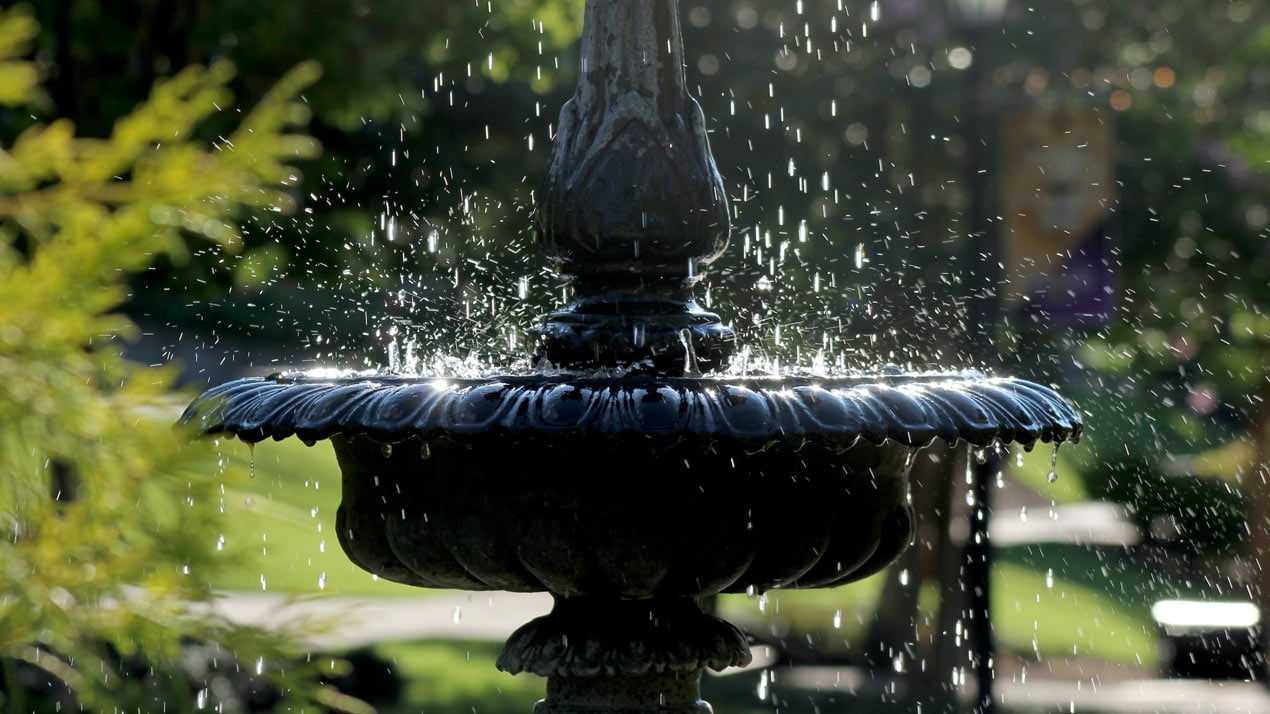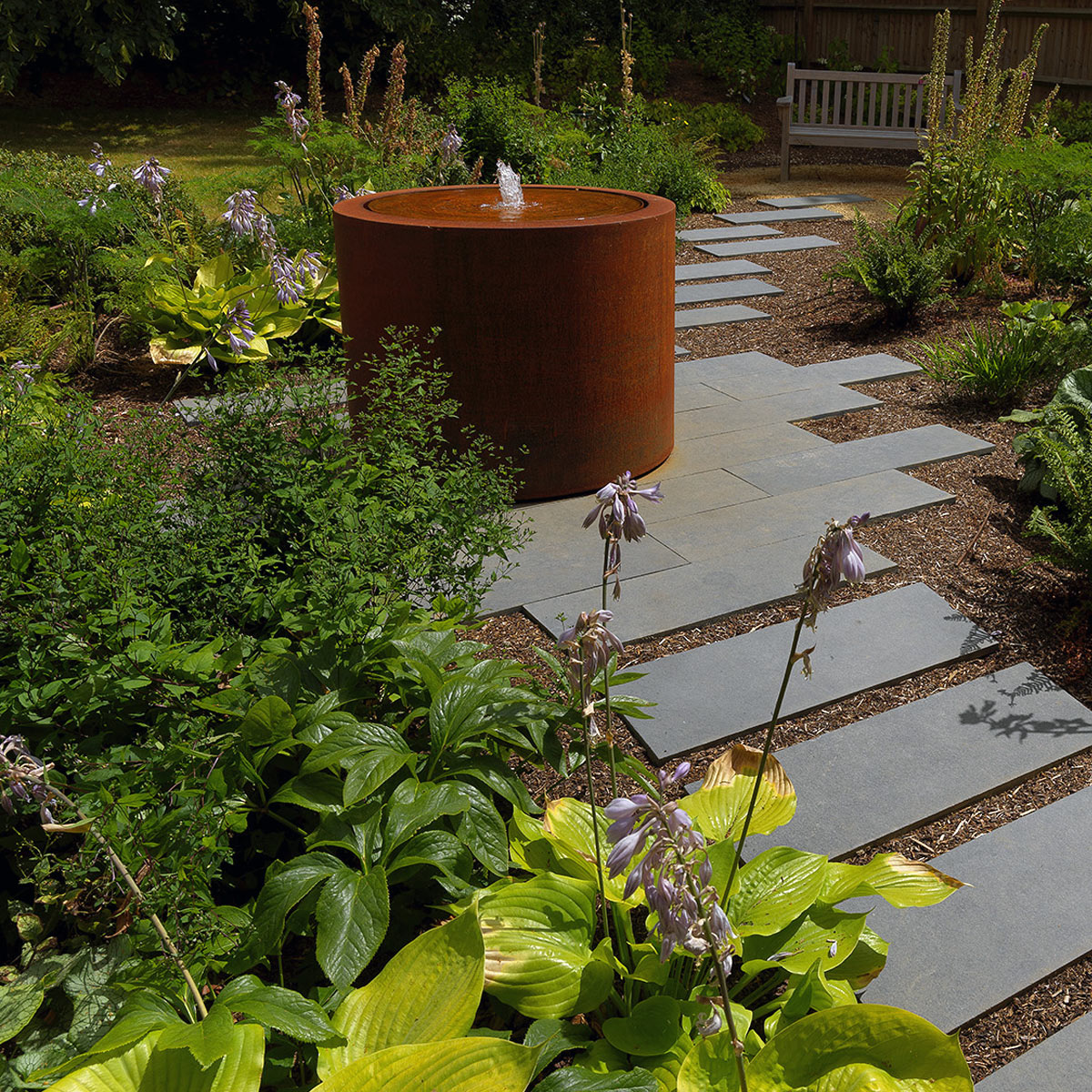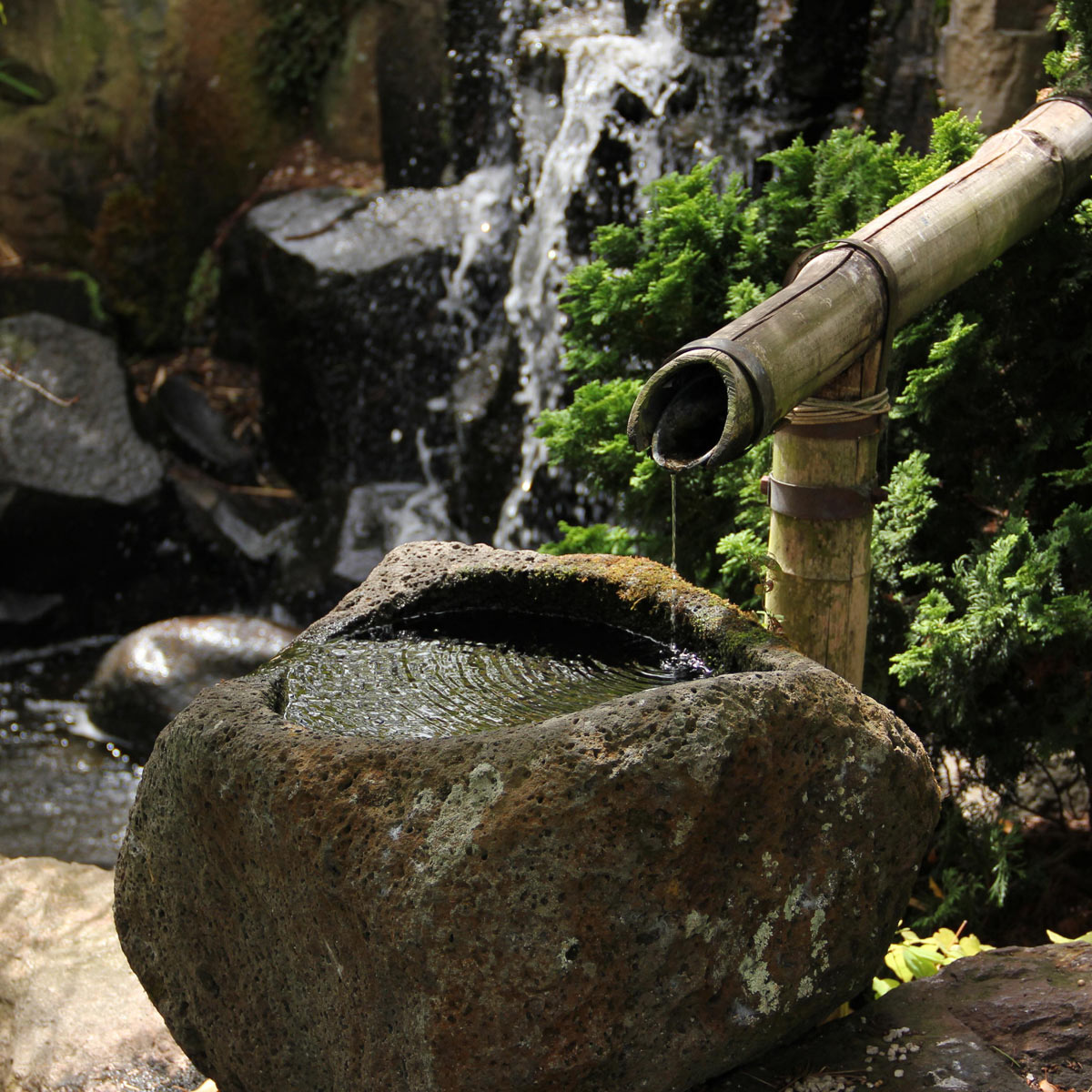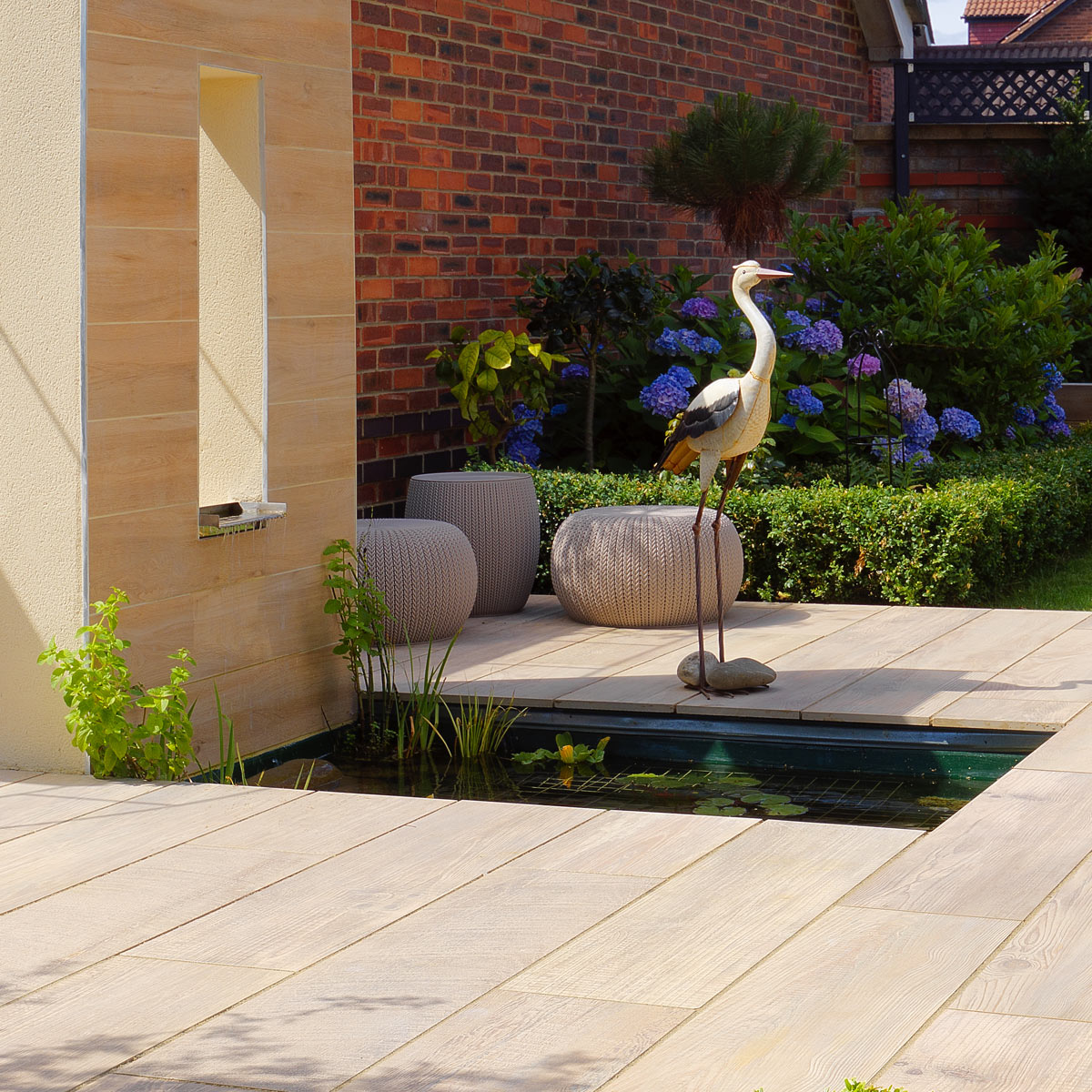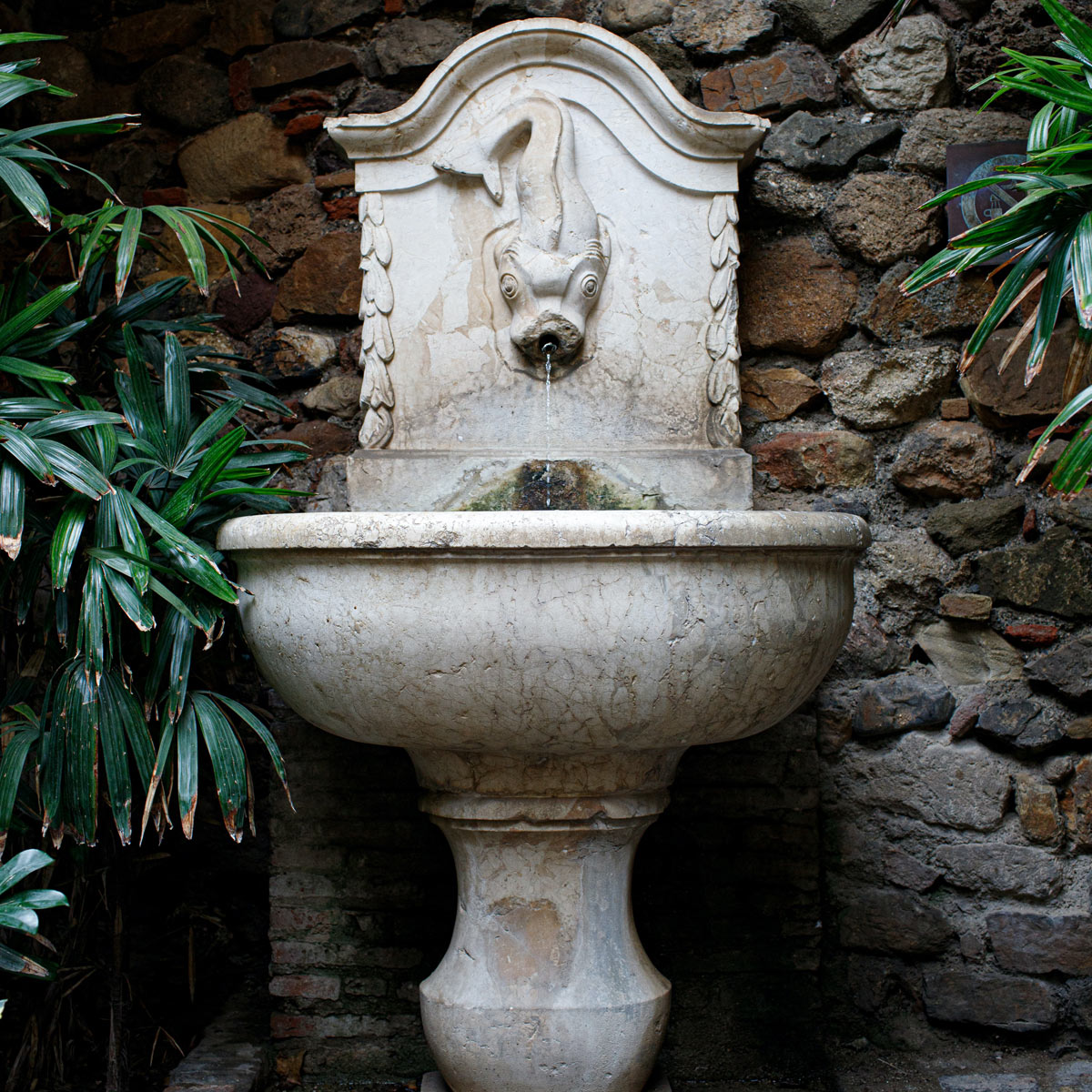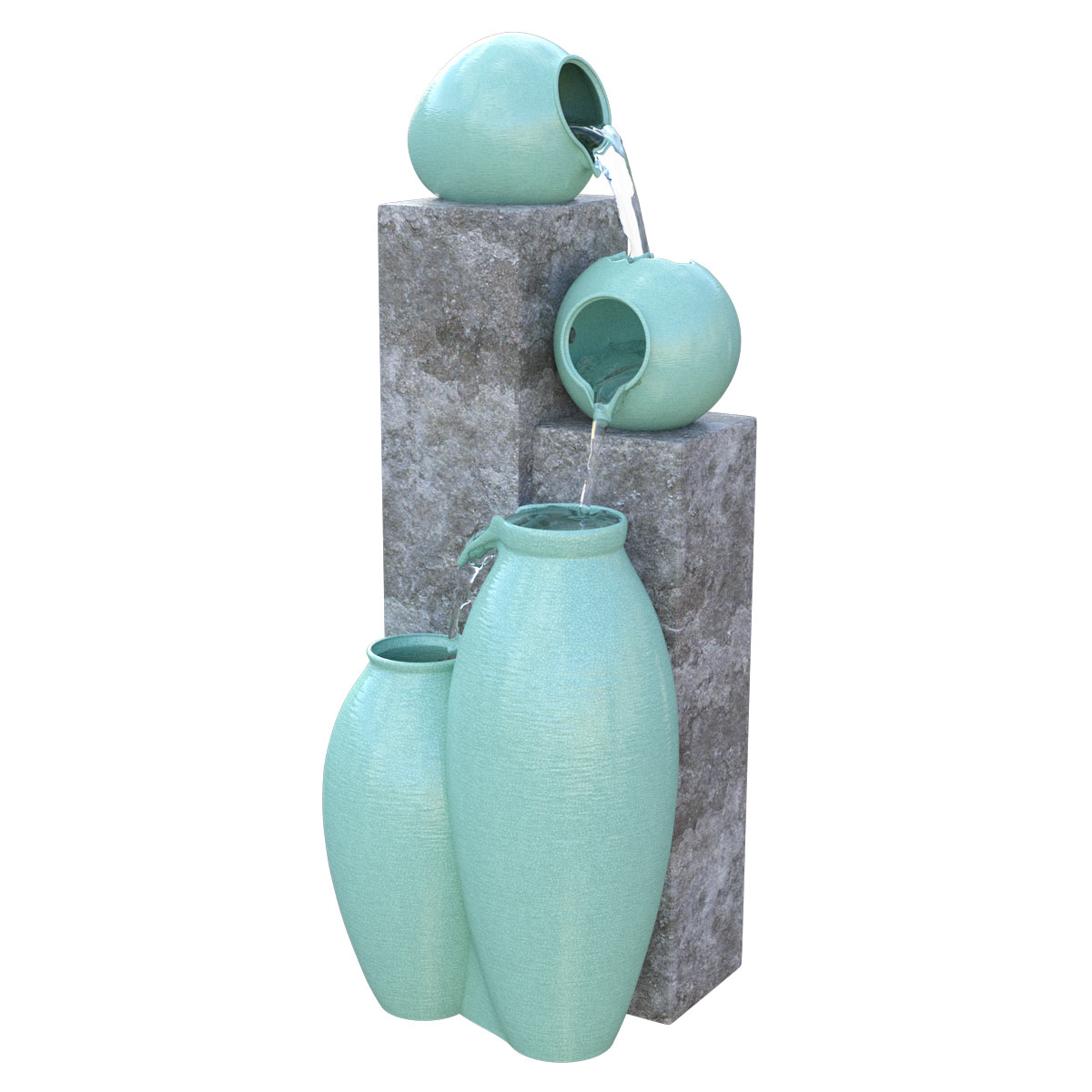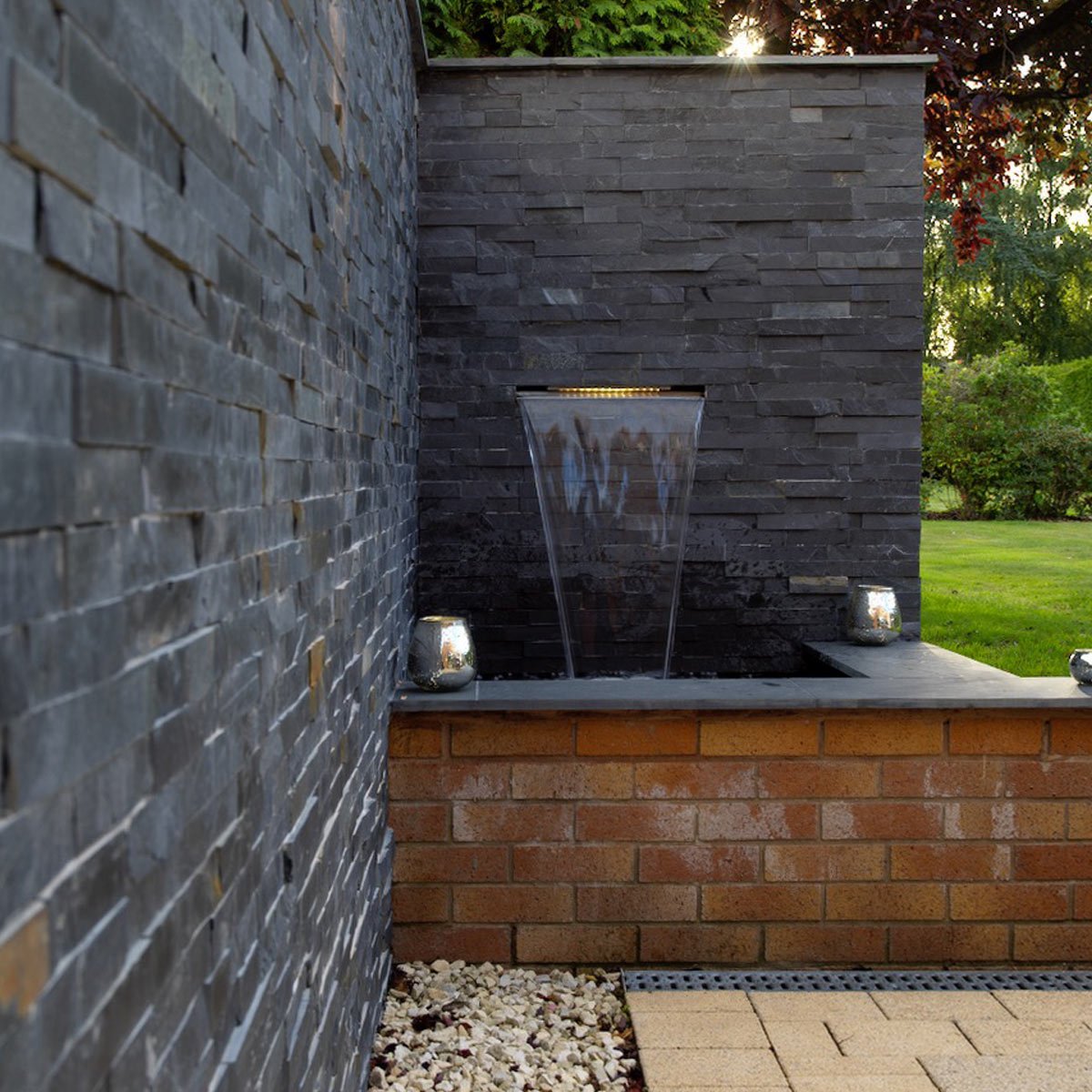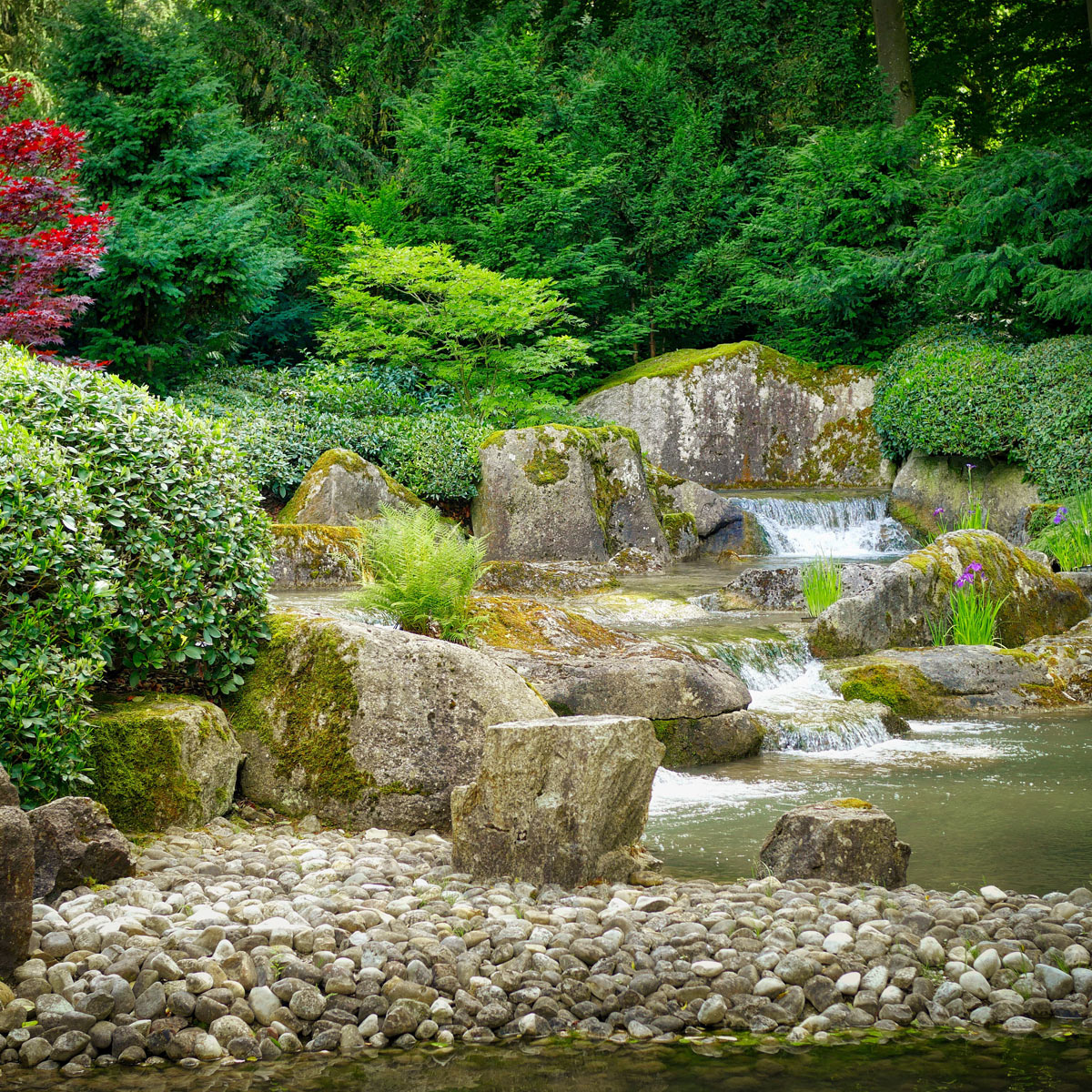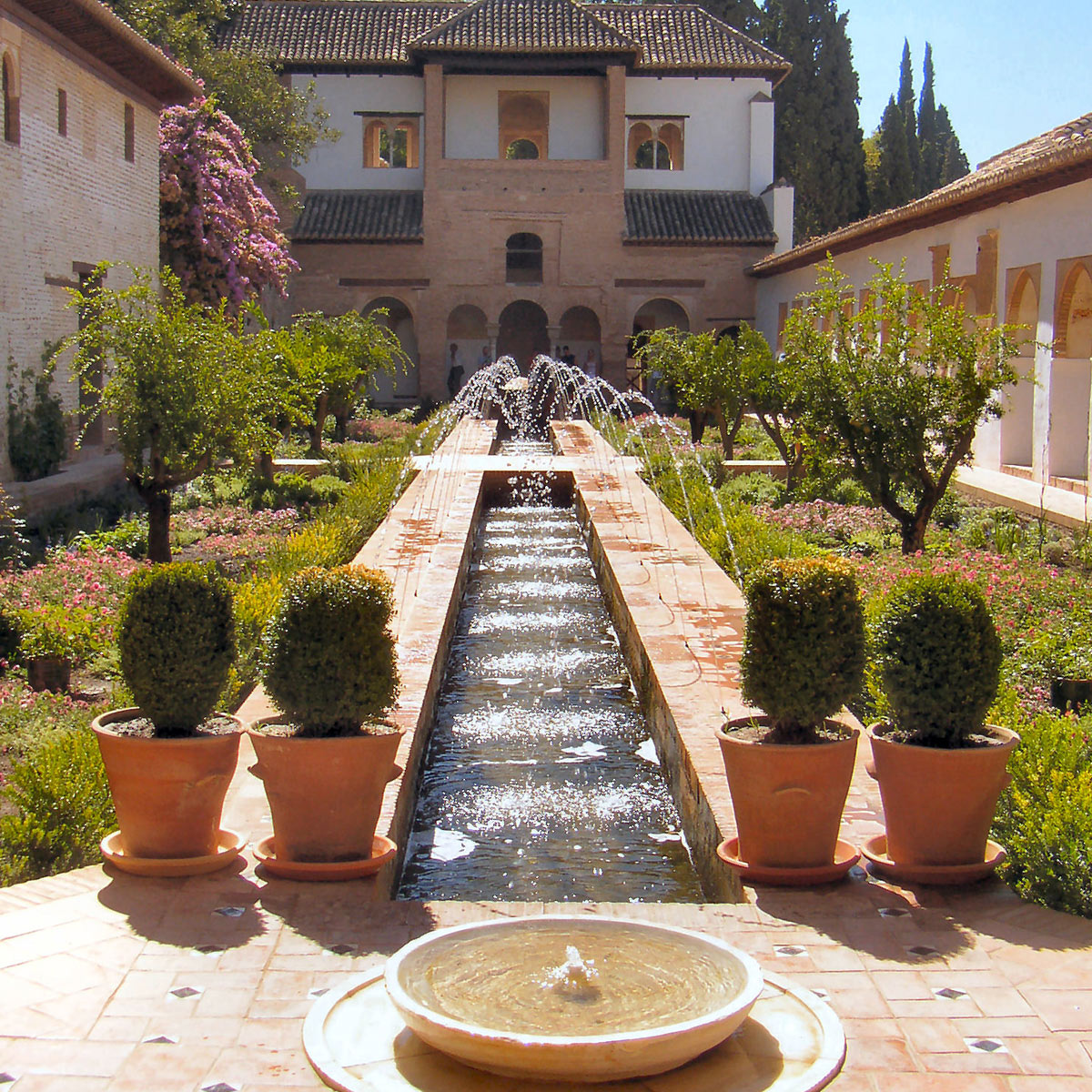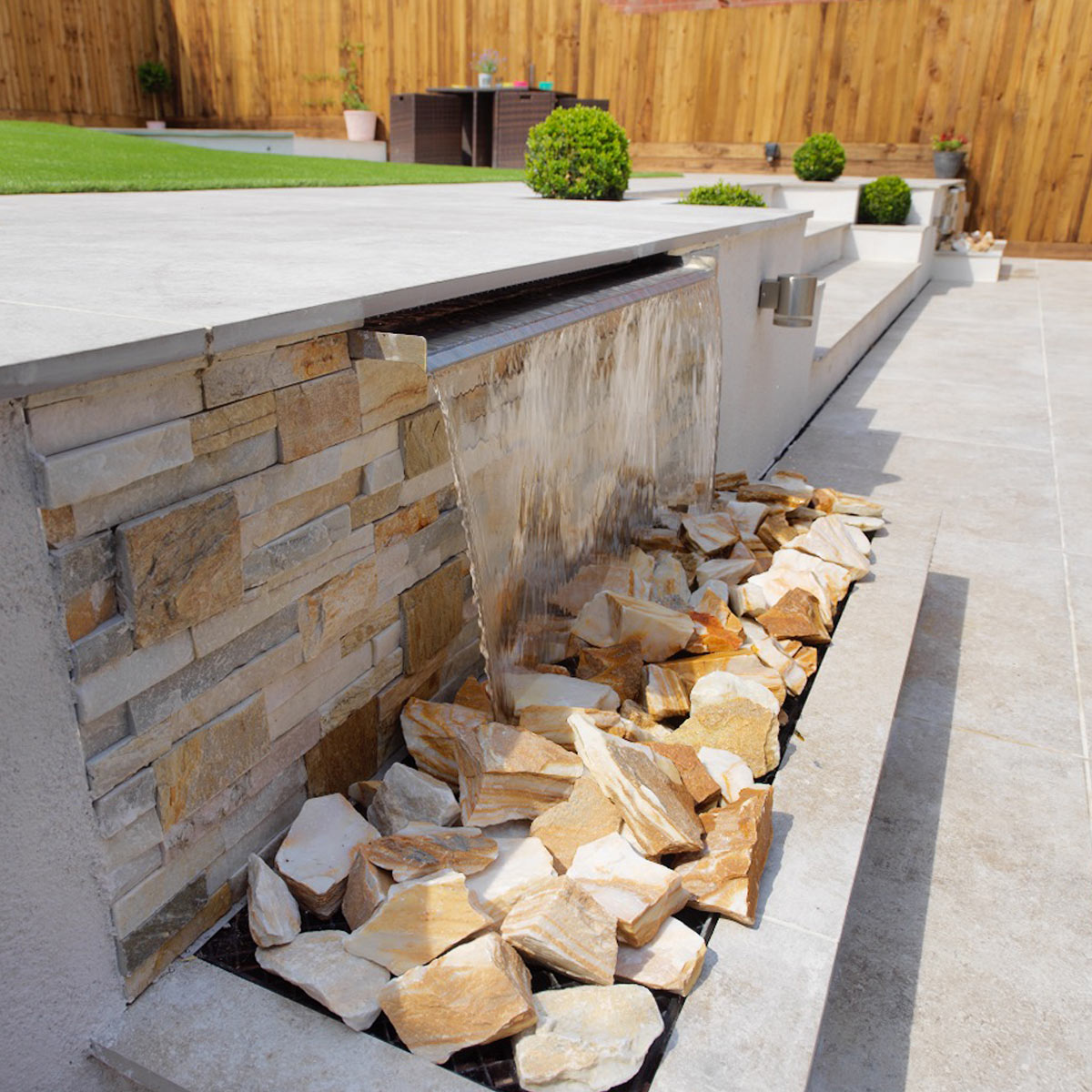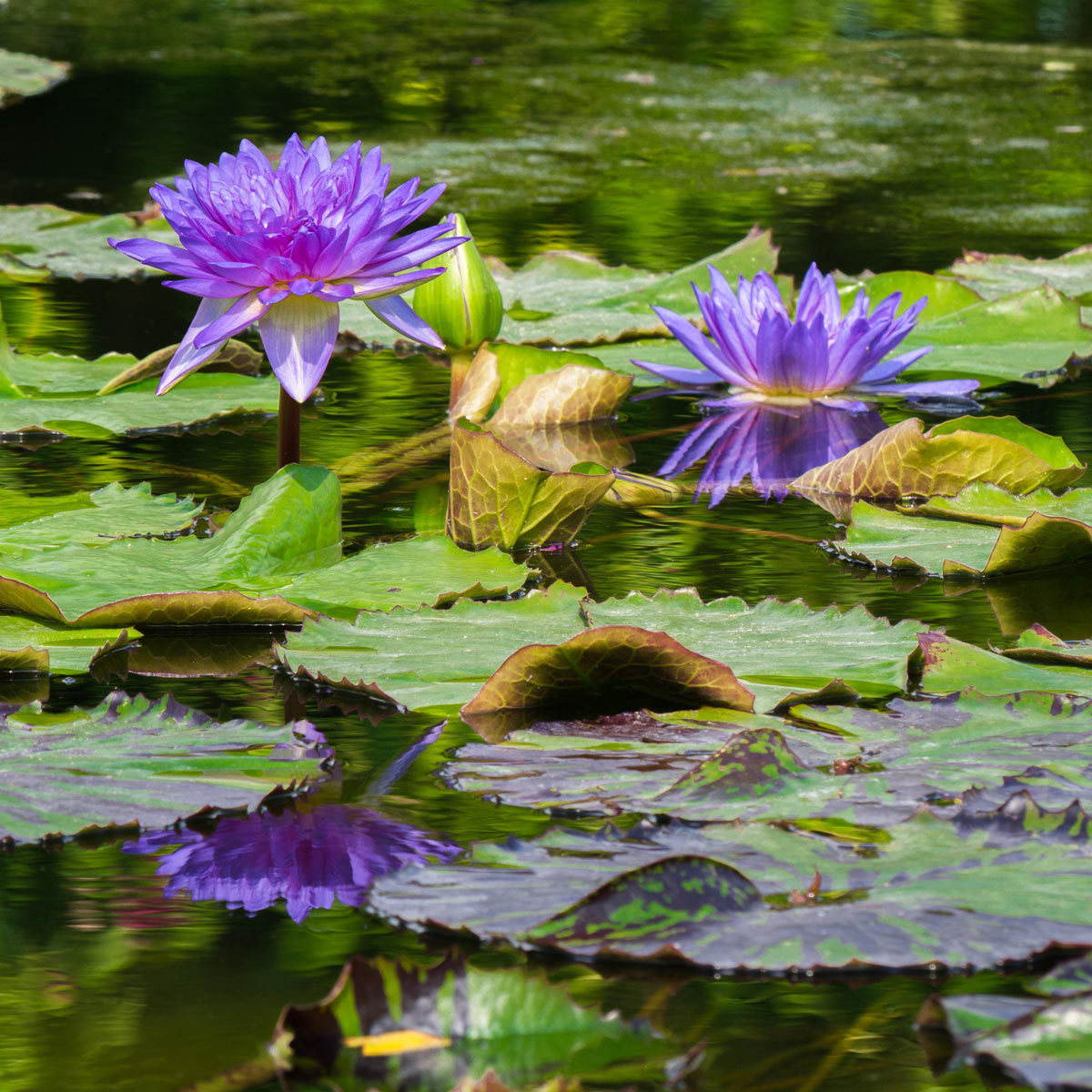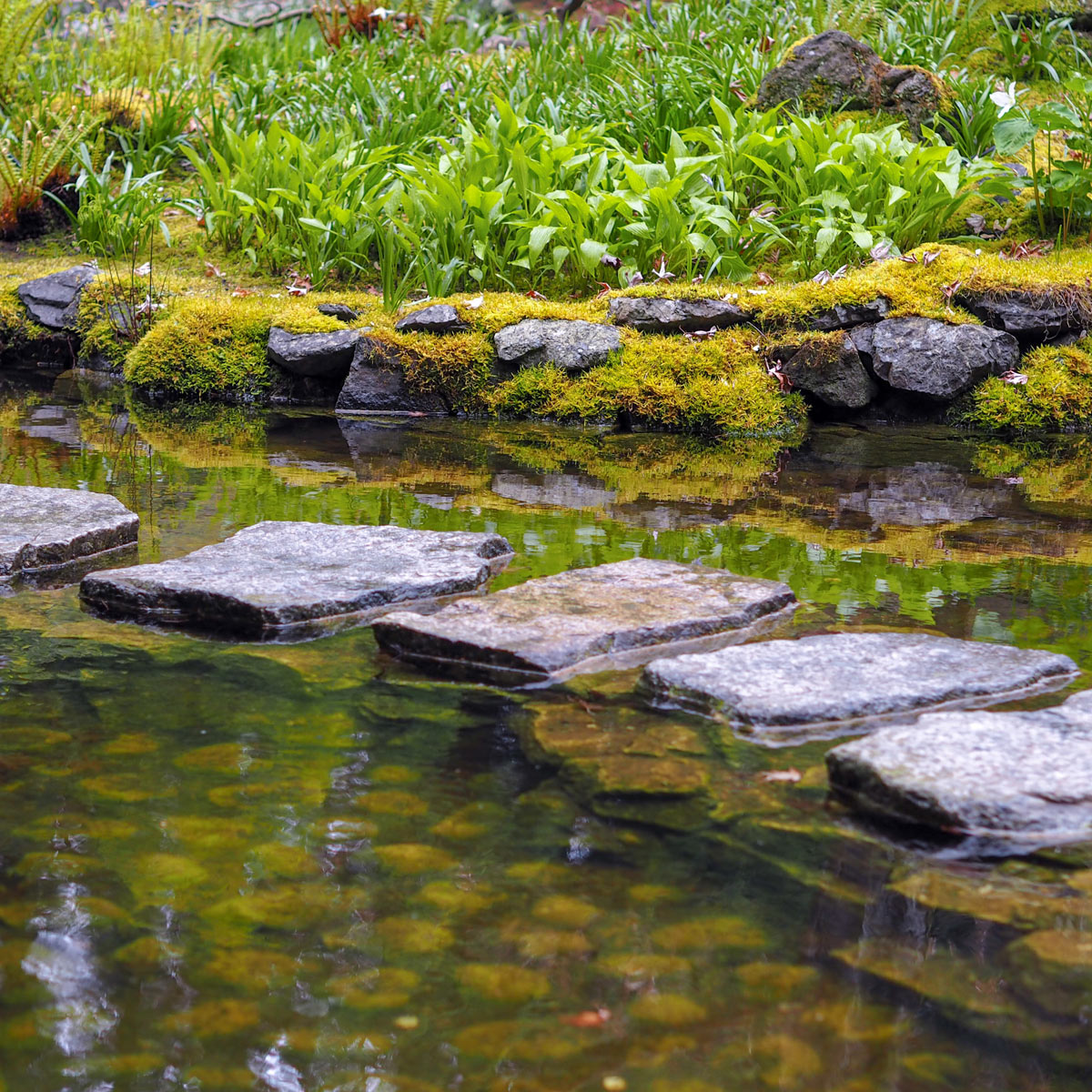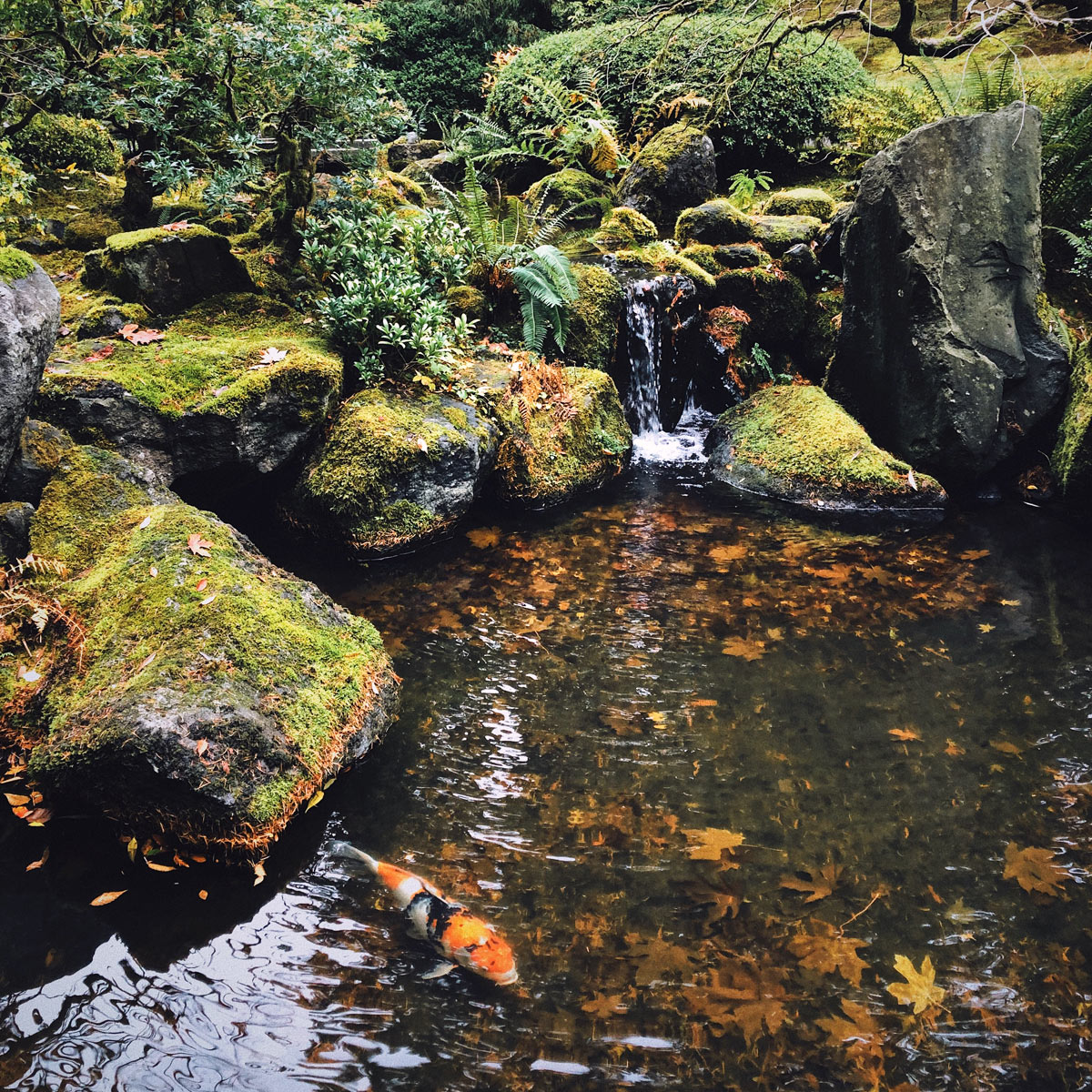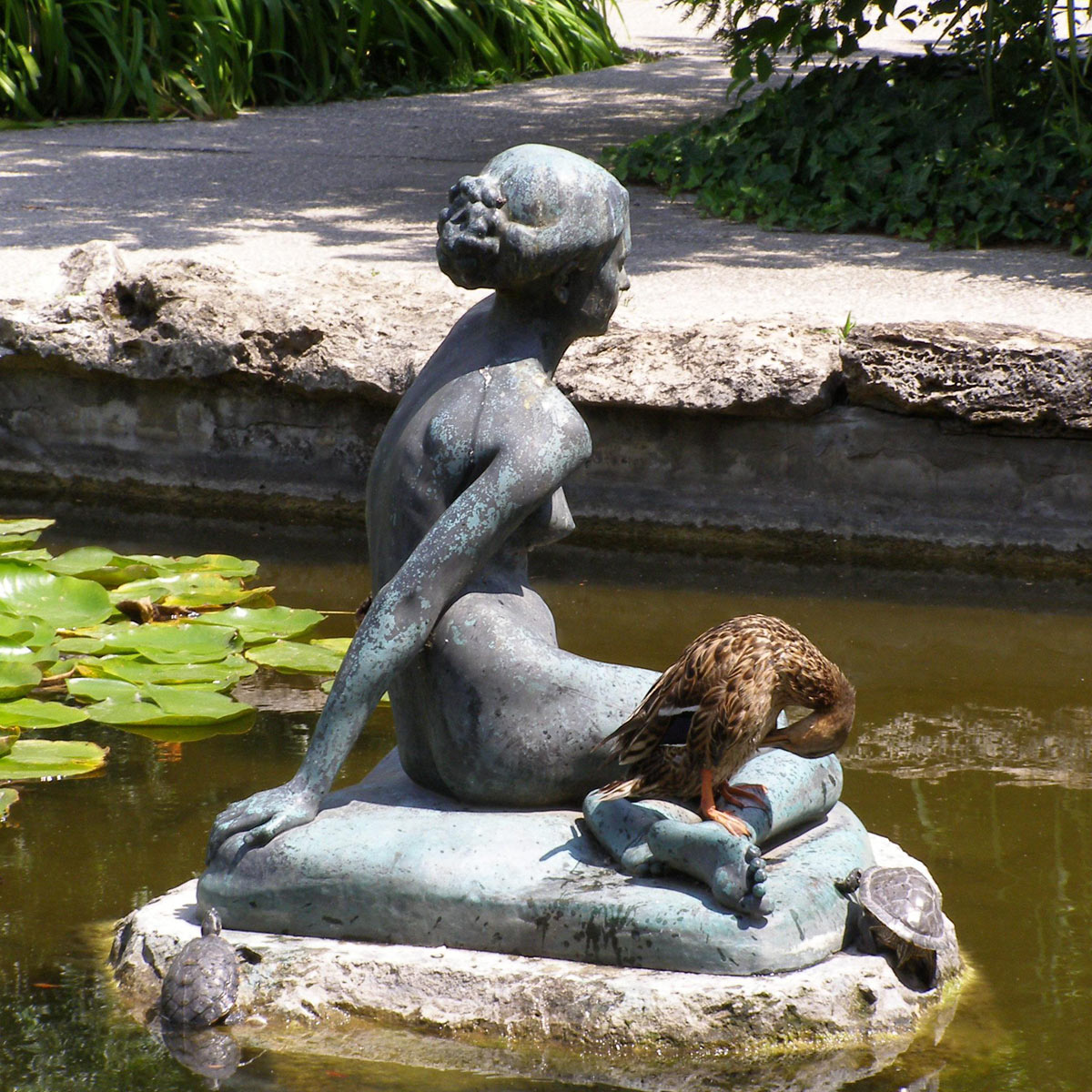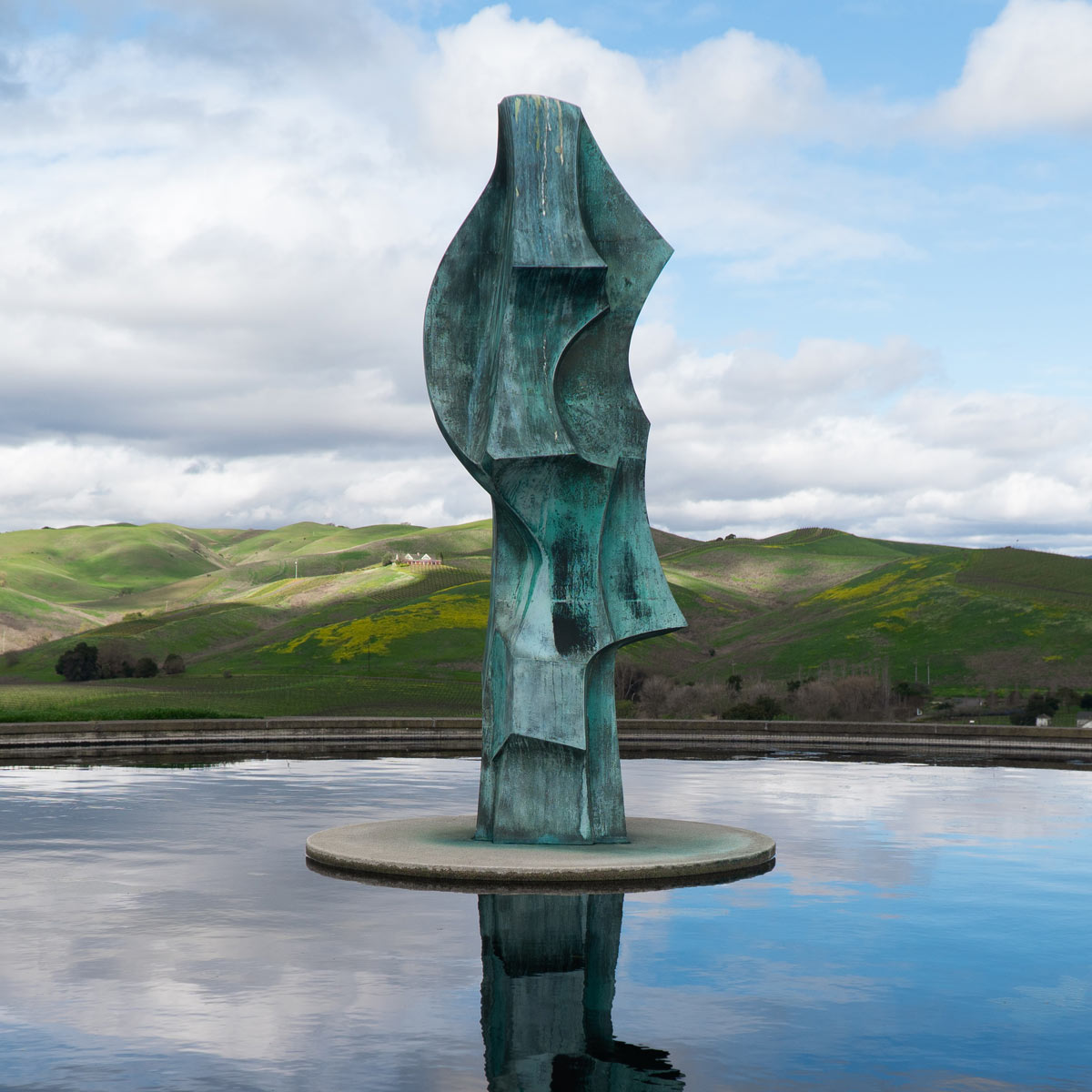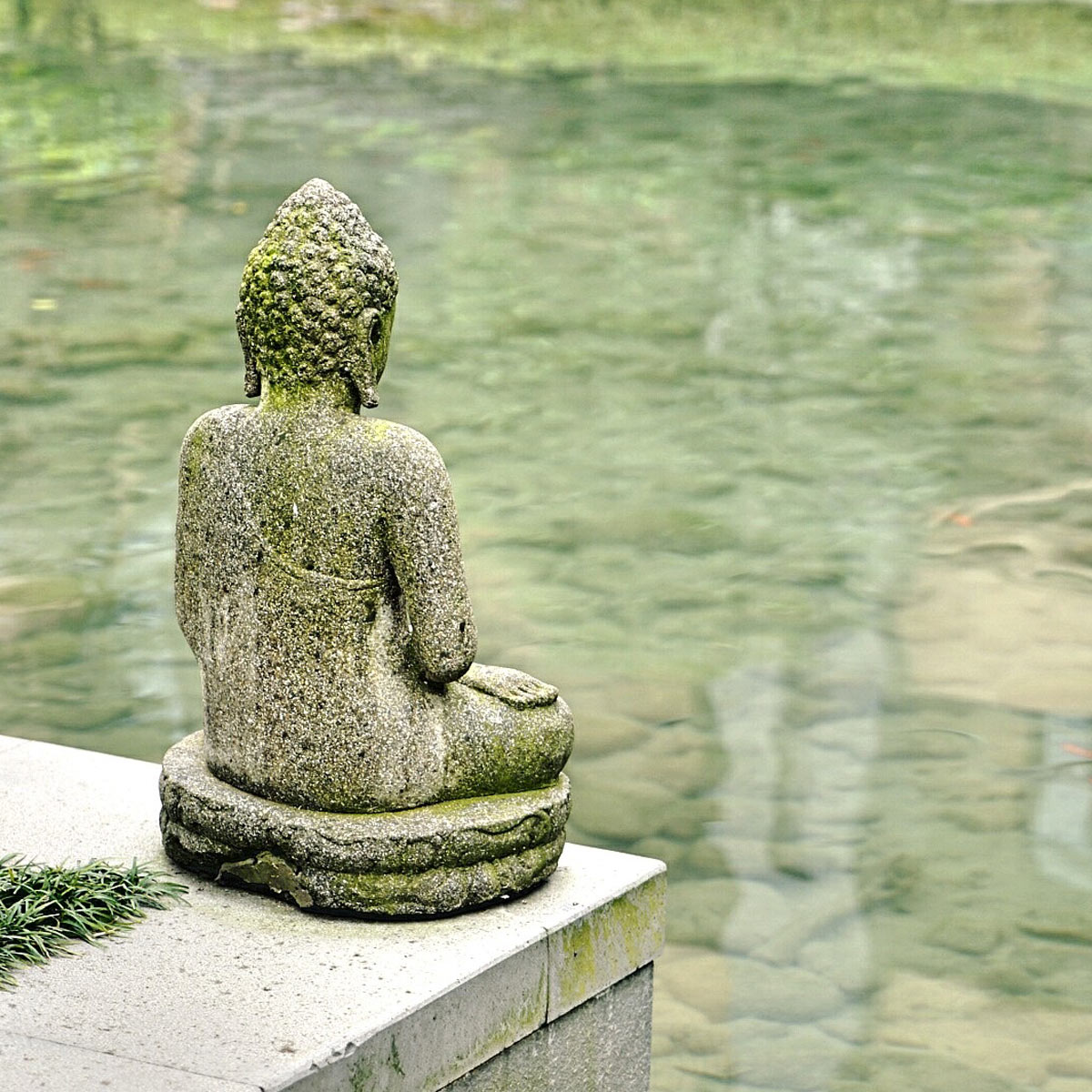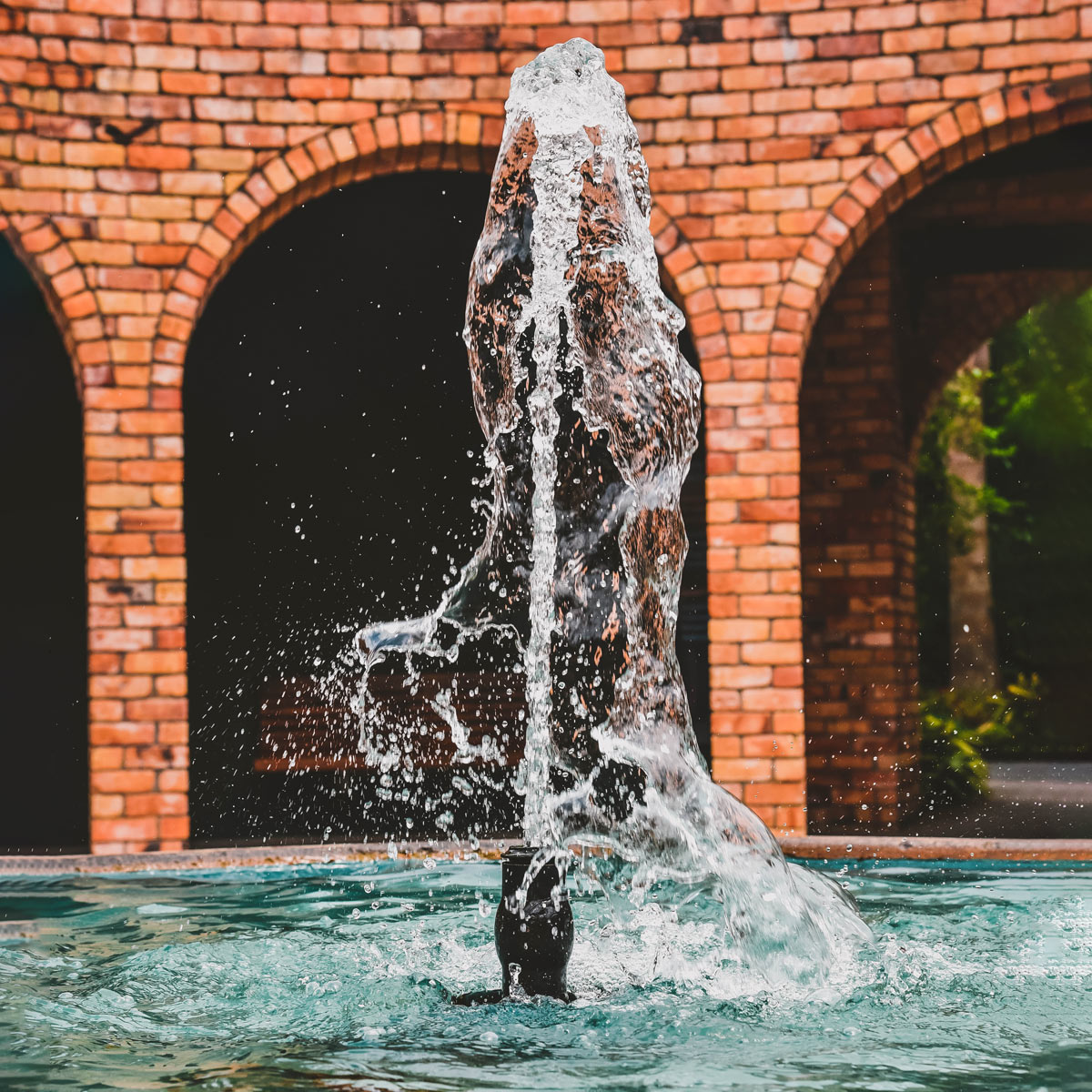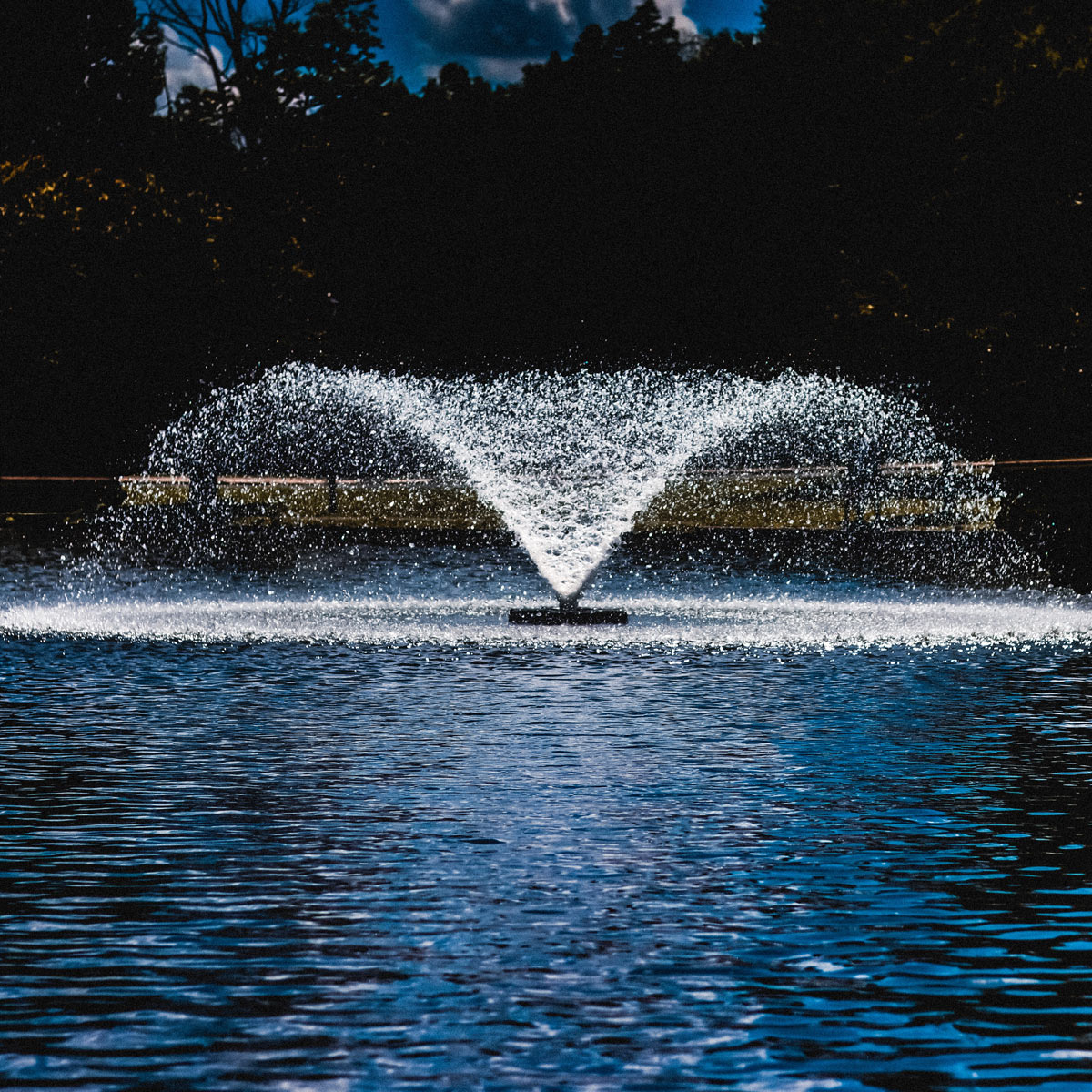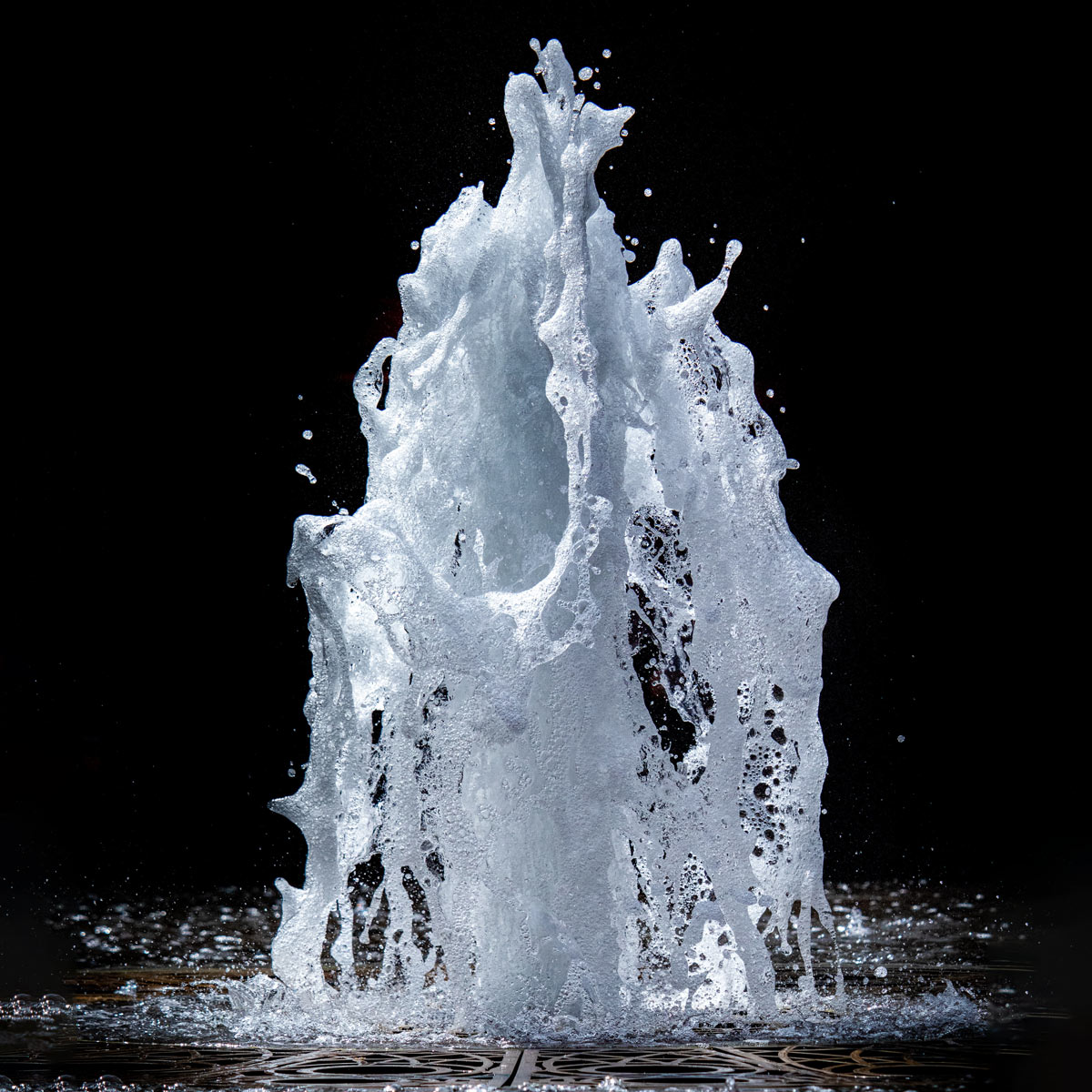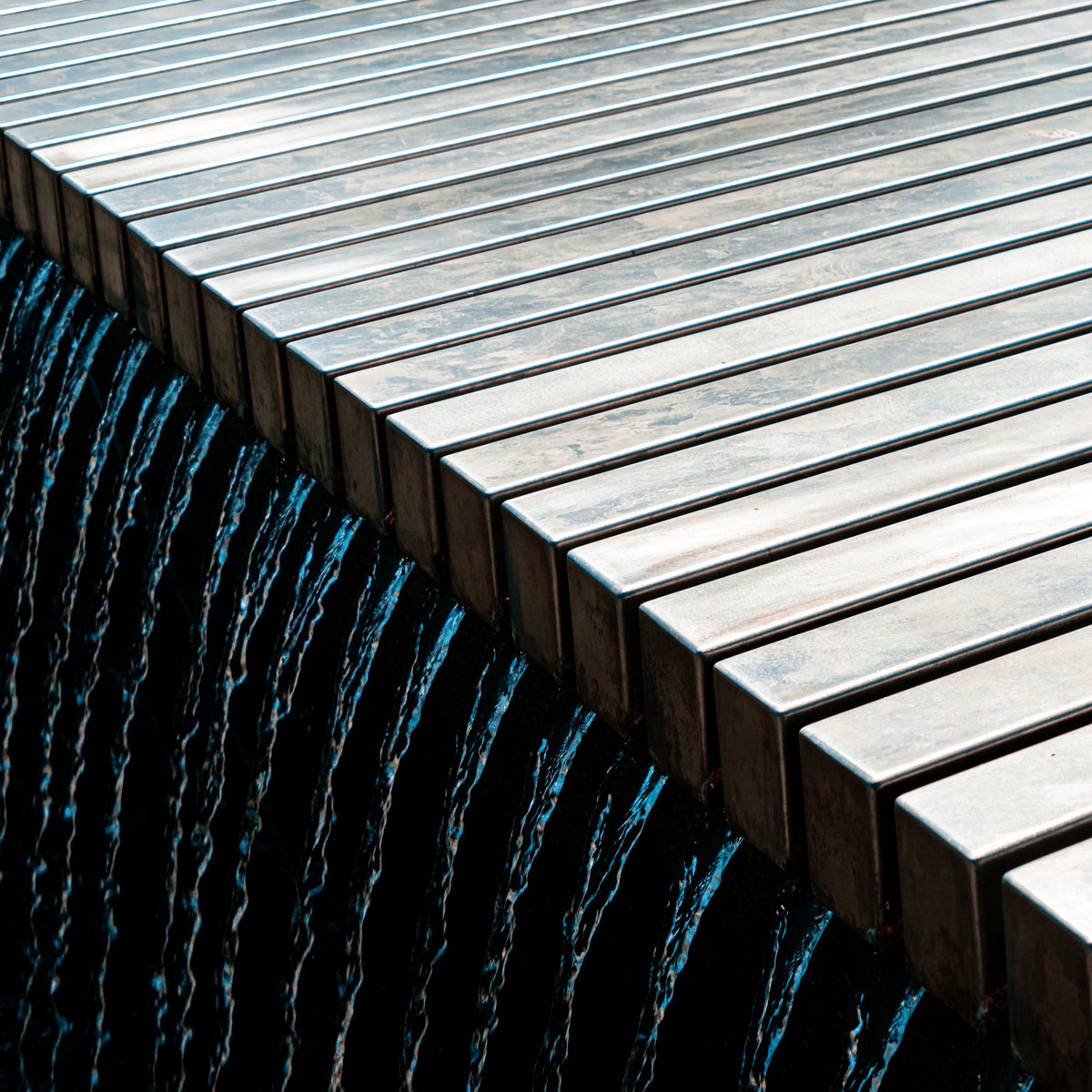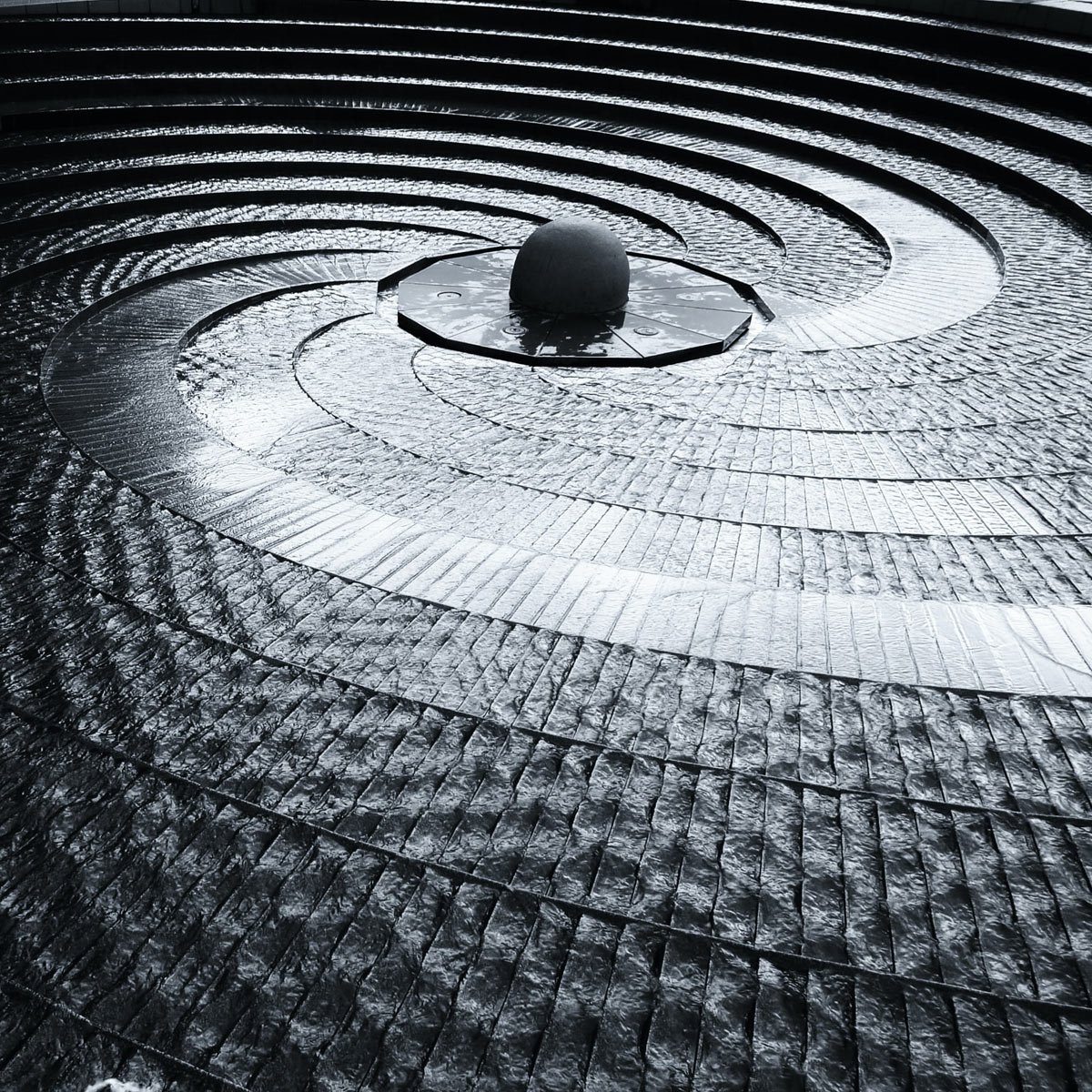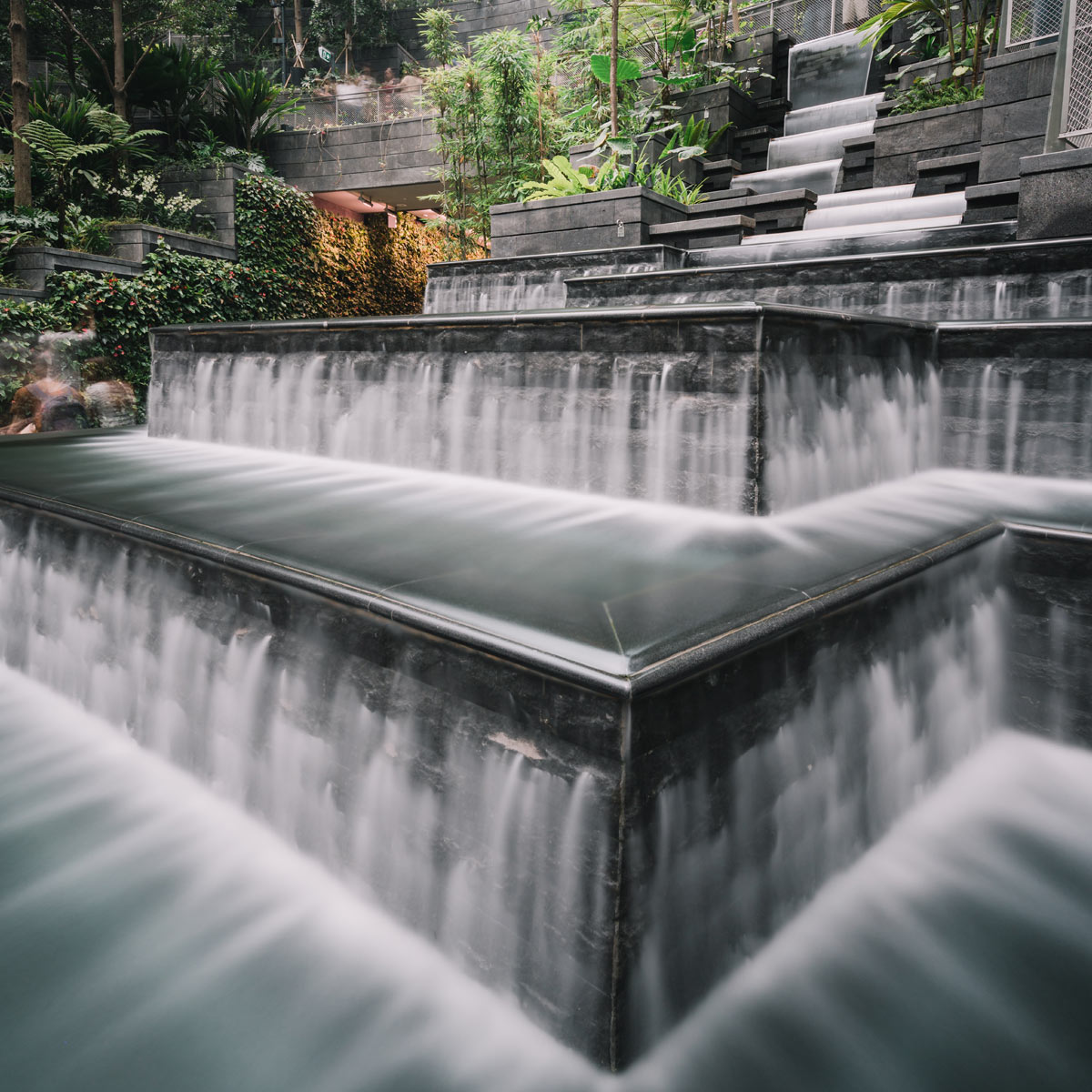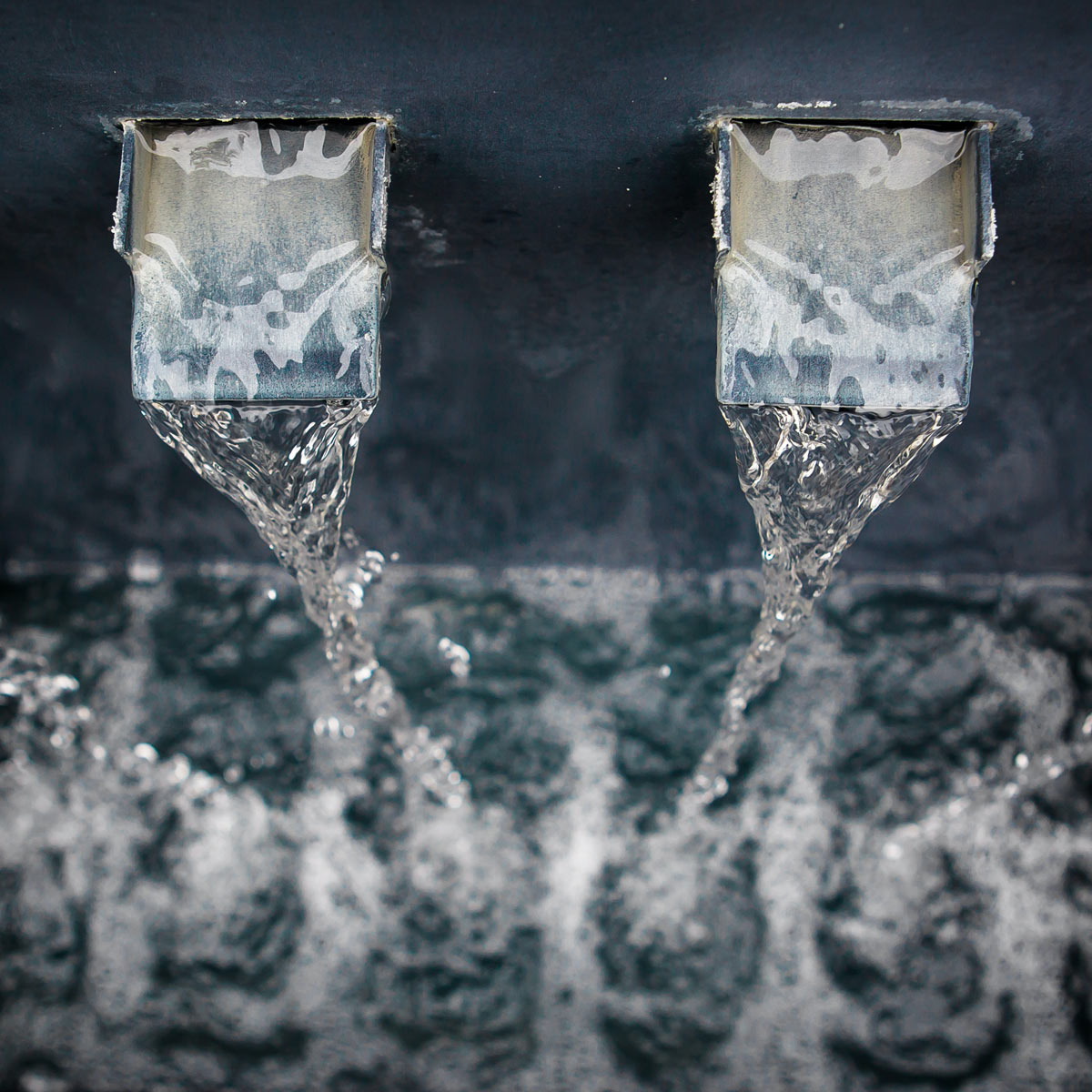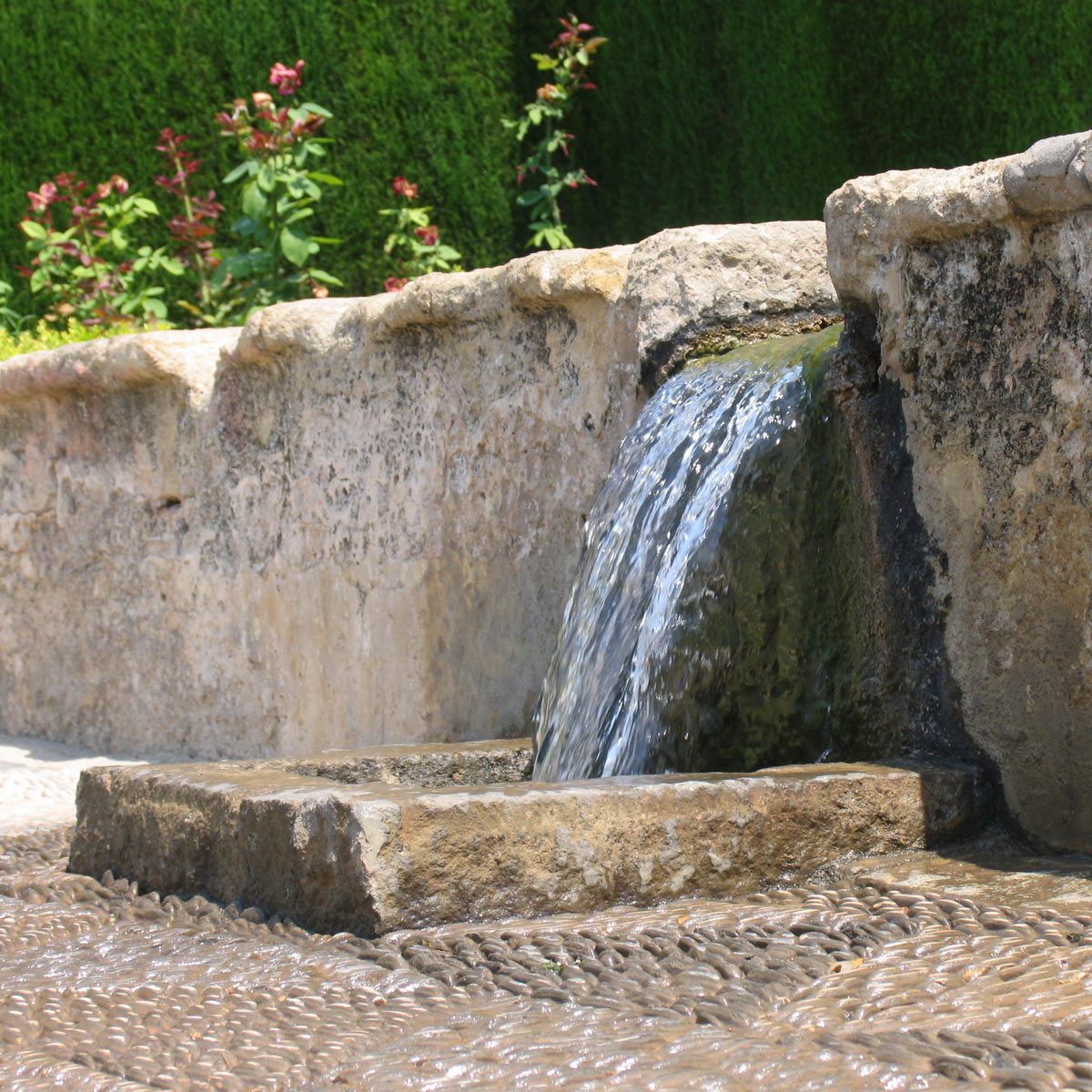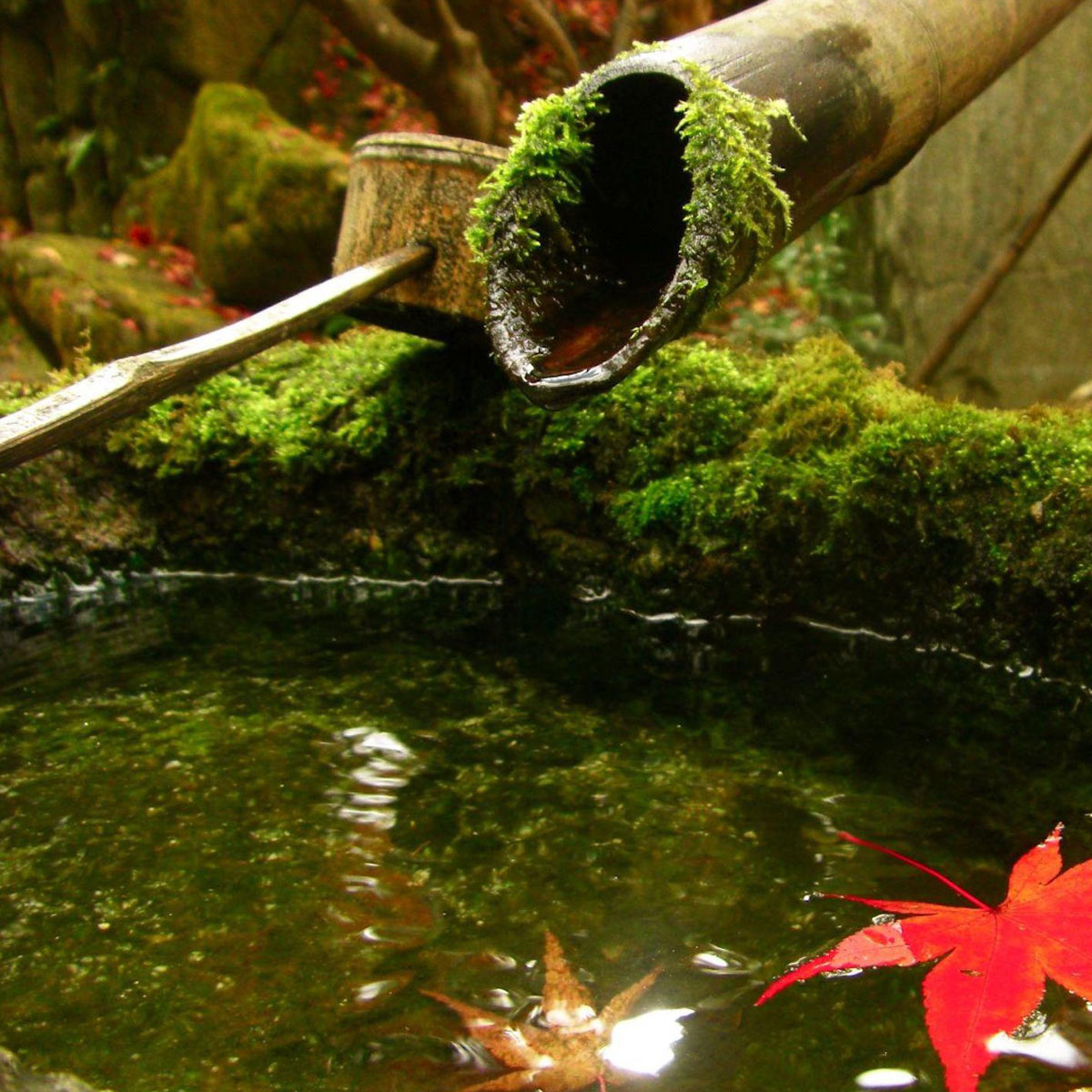If you’re looking to refresh your outdoor space, a water feature is the perfect idea. Not only can it attract wildlife to your garden, but it also creates a calming atmosphere, and a relaxing background noise. This in turn can help to lower your blood pressure, improving both your physical and mental health.
Water features are easy to maintain, as they need minimal cleaning and will reuse rainwater for a constant flow. They can also help to tie your garden together by softening hard features such as walls and outbuildings.
We have put together a list of water feature ideas to inspire your next garden project.
Garden Fountains
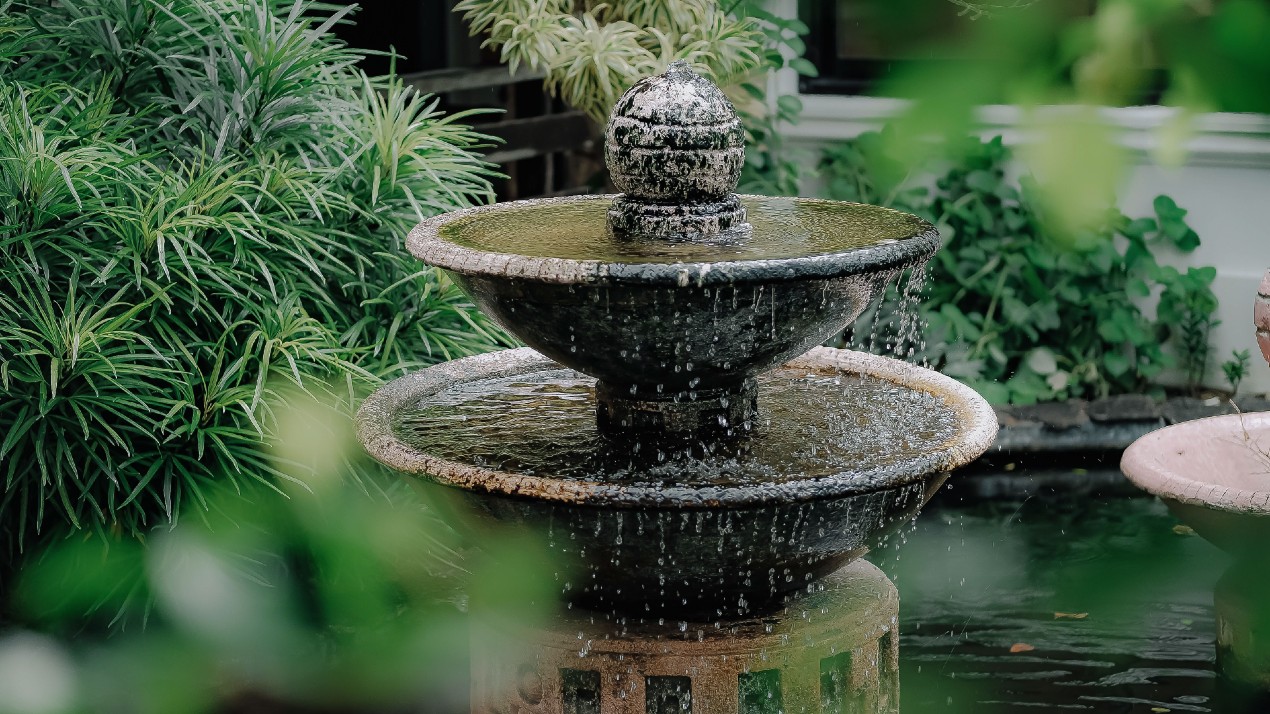
To create a focal point in your garden, you could add a water fountain. There are many different styles available, from modern pillars to decorative spheres and even stone animal fountains. You can surround your water fountain with our range of circular paving stones to create a relaxing space in your garden.
Installing a water fountain could be a positive move not only for the appearance of your garden, but also for your mental health (particularly if you spend a lot of time in your garden). Extensive research has highlighted the stress-alleviating qualities of artificial water features like fountains.
Tiered water fountains
A popular and widely used water feature idea, tiered fountains have a central spout/s with multiple tiers of pools below. The top pool collects the water from the spout, and this then overflows/cascades into the lower-tier pool. This overflowing into lower tiers continues until the bottom pool is reached, at which point the water is pumped back into the spout to continue the cycle.
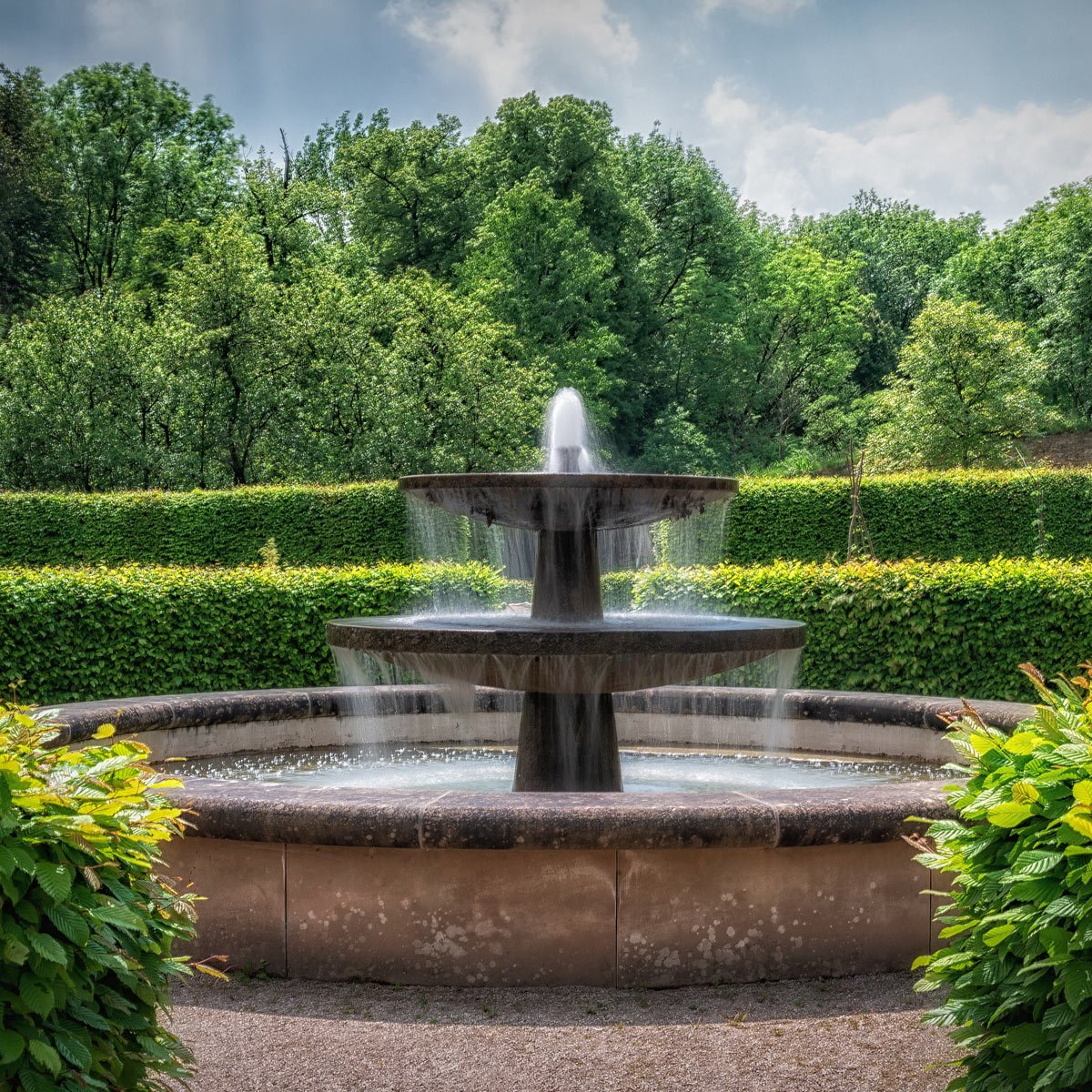
Wall fountains & sconces
Wall mounted spouts and sconces allow you to add decorative features to a surface. These can be highly ornate and sculptured, or minimalist, with little or no adorning. Human and animal heads are popular, but geometric shapes and abstract or geometric motifs are just as popular too. Wall mounted fountains will usually have a rectangular or half-circle collection pool, into which the water will fall and be pumped back up to the spout.
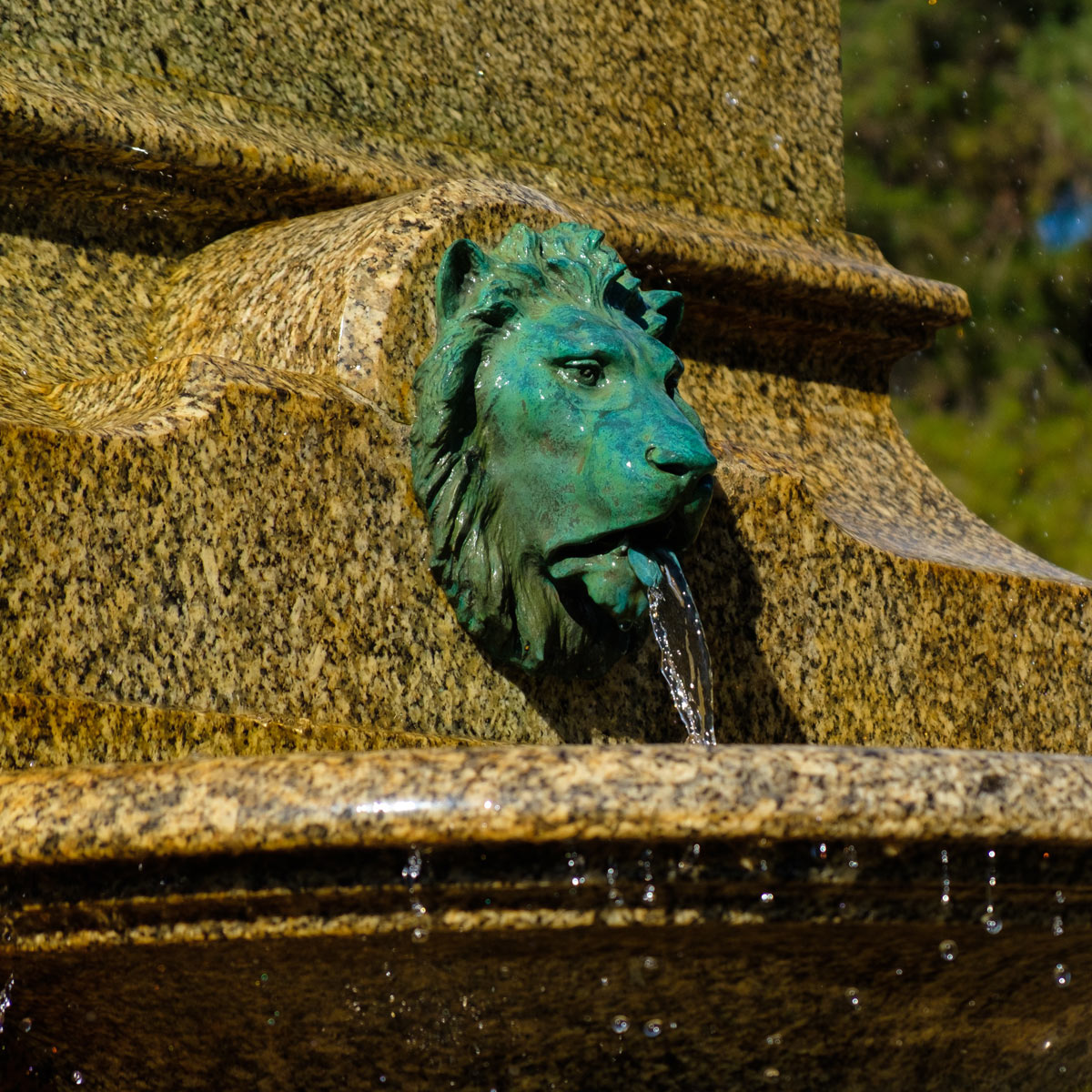
Vertical spouts & bubblers
These are amongst the simplest types of fountain, but with a certain degree of visual flexibility. A vertical spout in a pond or pool projects water up into the air, to fall back into the same pool. The spout containing the nozzle or fountainhead is small and unobtrusive, so the visual appeal of these fountains comes from the water jets themselves. Bubblers are similar, but the nozzle/fountainhead is submerged under the water line.
Different nozzles/fountainheads and varying water pressures can produce an array of different water jets, from fans with multiple streams, to high white-water jets (geyser heads) and billowing low white-water (foam heads). Changing the water pressure through these type of fountains will change their appearance, making them aesthetically flexible, and able to convey a range from tranquil and gentle vibes, through to energetic and dramatic ones.
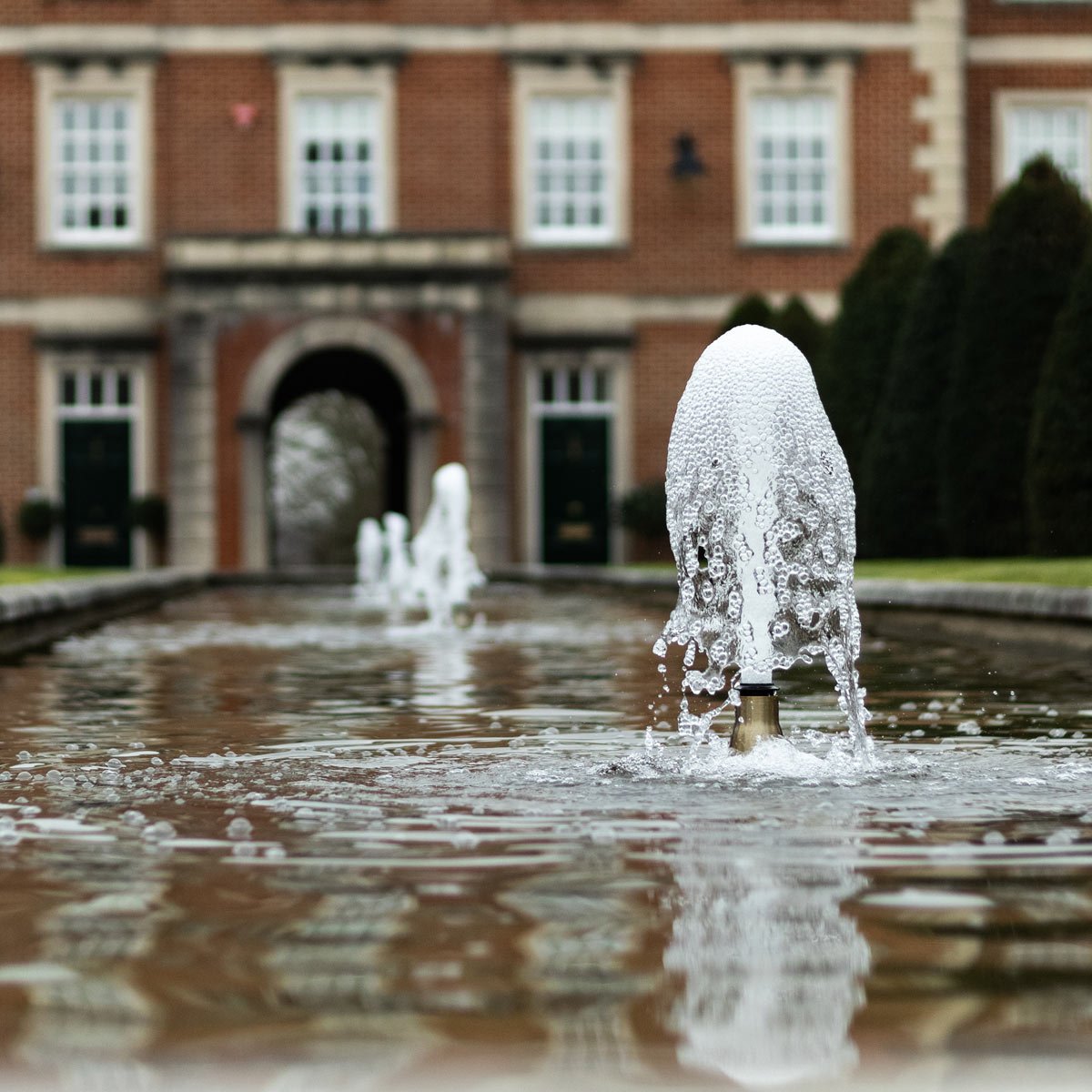
Plinth fountains
Plinth fountains are simple centre-pieces – they usually provide a small vertical spout, often styled in a classical/neo-classical manner with an urn or fluted bowl upon a plinth base.
They’re great when space is limited or you just need an eye-catching feature to draw in the viewers’ eye. Plinth fountains can be made of natural stone, reconstituted stone or simply concrete. If you are trying to get something that looks period and well established, try painting the surface with diluted plain natural yogurt to encourage lichen growth.
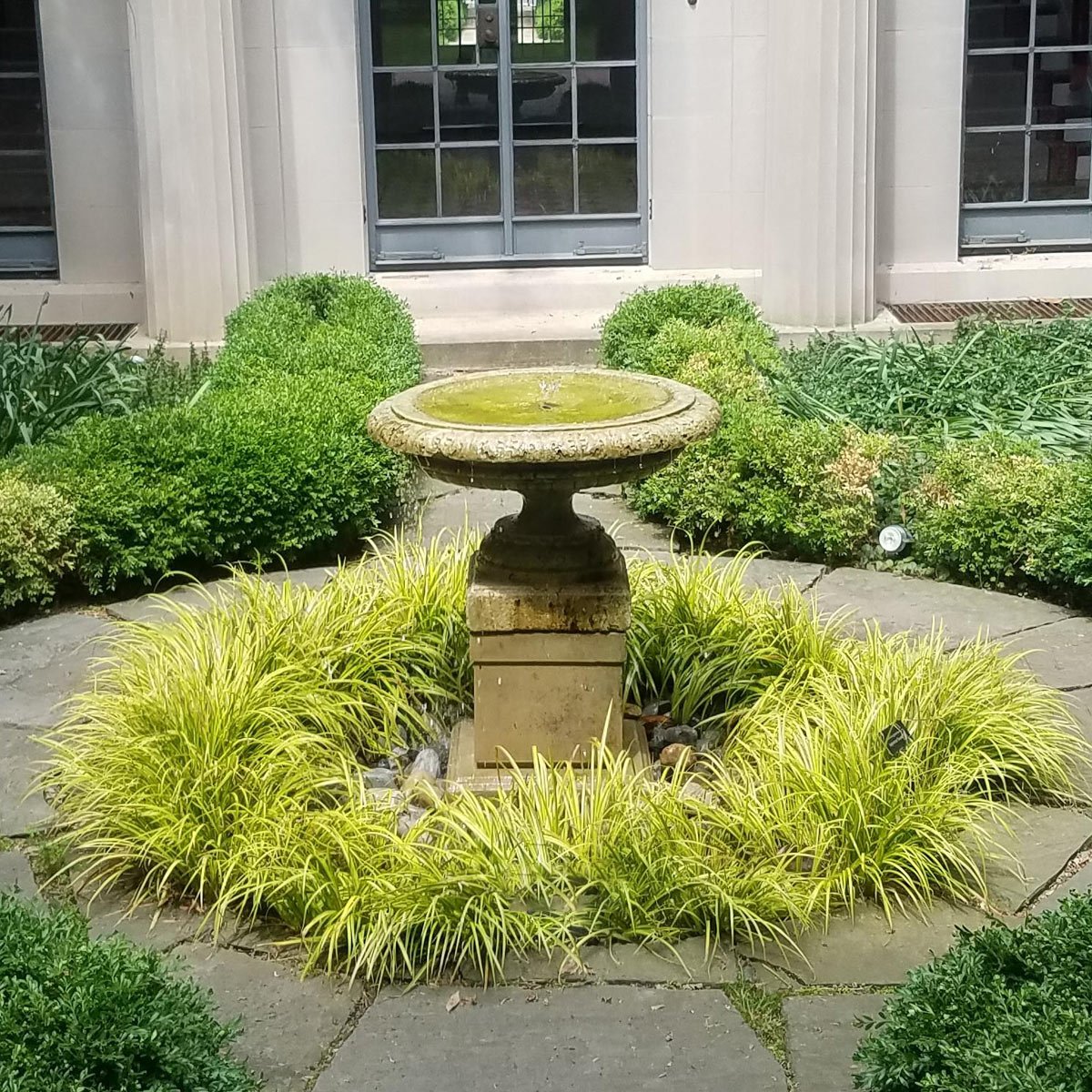
Flowing jugs
If you’re looking for more unique and innovative fountain water feature ideas, then flowing jugs could be an option to explore. These can be positioned on the edge of a pond or can also be purchased as a standalone water feature with a pump. Pouring jugs can add a touch of elegance to your garden, creating a peaceful background trickling noise.
You could choose a traditional terracotta jug or go for a modern look with a metal design. Wildlife will flock to your garden for a refreshing drink – you can simply sit back and take it all in.
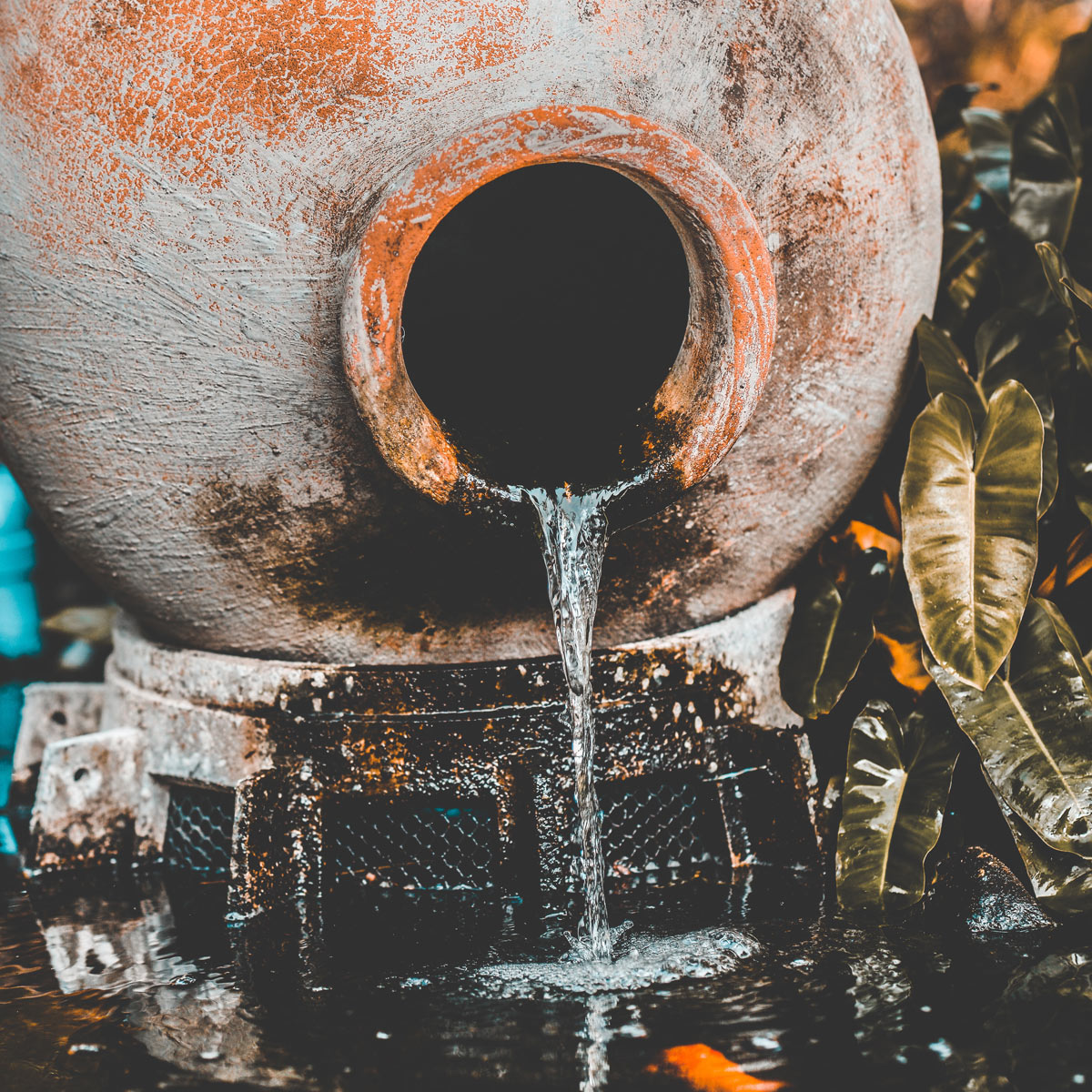
Rockery fountains, pebble piles & babbling brooks
These fountains use rocks and stones to create a natural looking setting. Water pours or cascades through the rocks to a lower pool, where it is pumped back up to the top. These “Babbling Brook” or rockery fountains, provide a bucolic and rustic look and are great in cottage gardens or similar properties. We recommend using local stone or a good match when making these water features. They are designed to look natural, so the stone should be in-keeping with the property and landscape where possible.
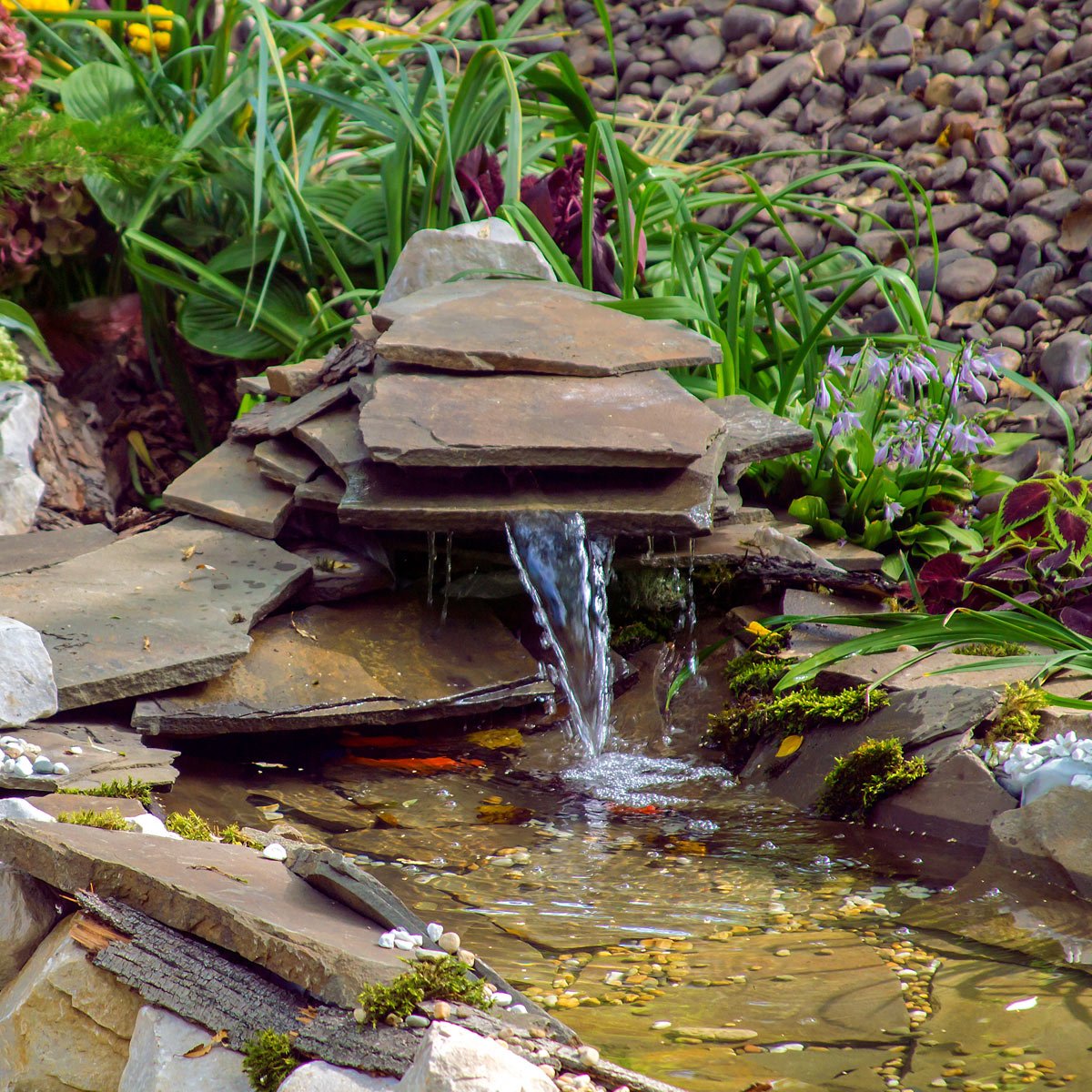
Jeux d’eau (water games)
The term jeux d’eau was introduced during the mid-16th century as a catch-all phrase to describe water features as these became more common in grand homes of the French nobility. However, our modern usage is more literal, referencing the transliteration of “water games” meaning water features that are both playful and somewhat interactive (to be played with). These are seen more commonly in public spaces, such as piazzas and squares, but are just as apt to describe a variety of playful water features in domestic settings.
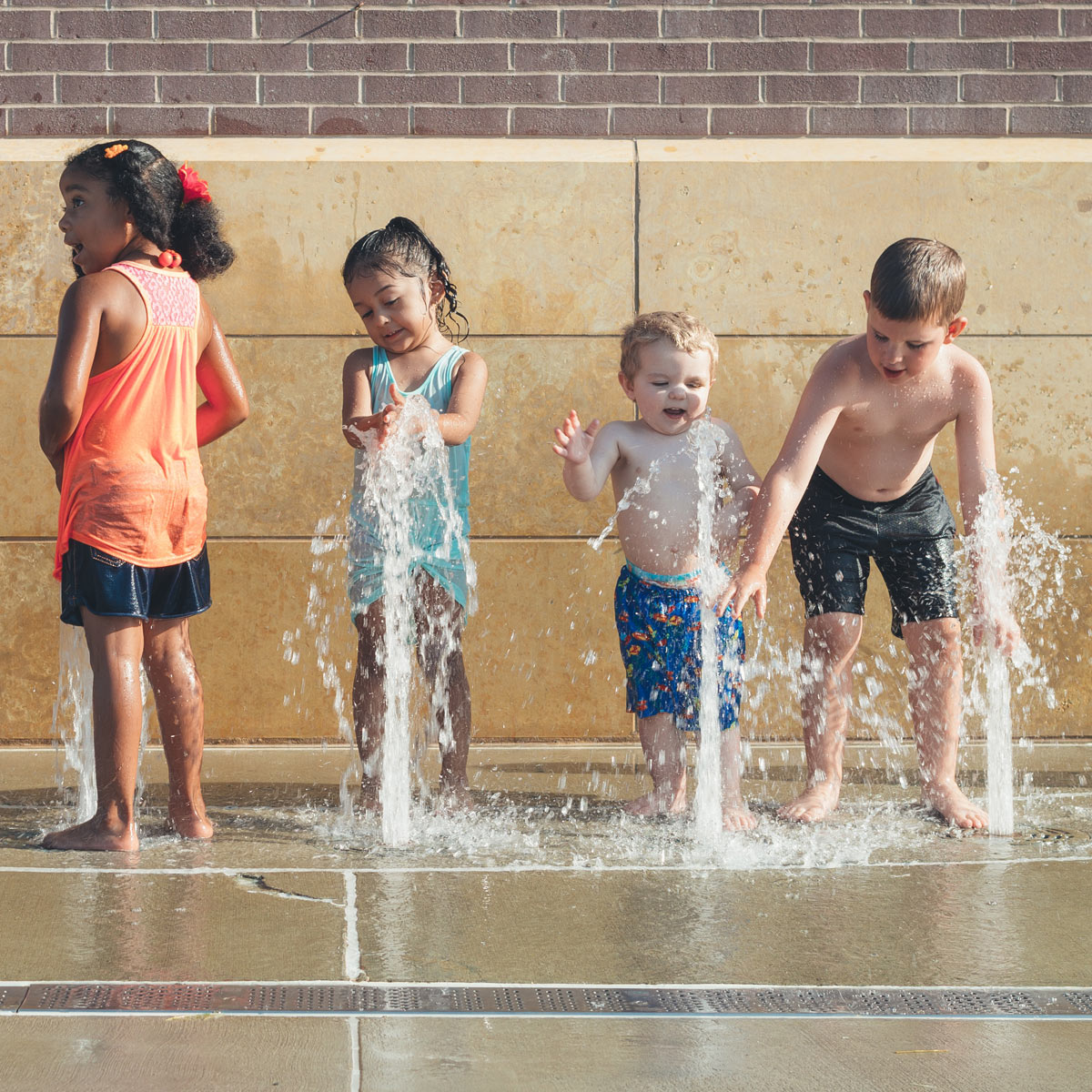
Water sculptures
A water sculpture is the perfect garden water feature idea for making a statement – and your choice of sculpture doesn’t have to stick to tradition. Rather than the typical cherub-type statues that we’ll all have seen at public gardens and stately homes, you could opt for a more modern, cutting edge water sculpture or a design that says something about who you are as a person. The watering cans feature pictured below would be a great fit for an avid gardener, for example.
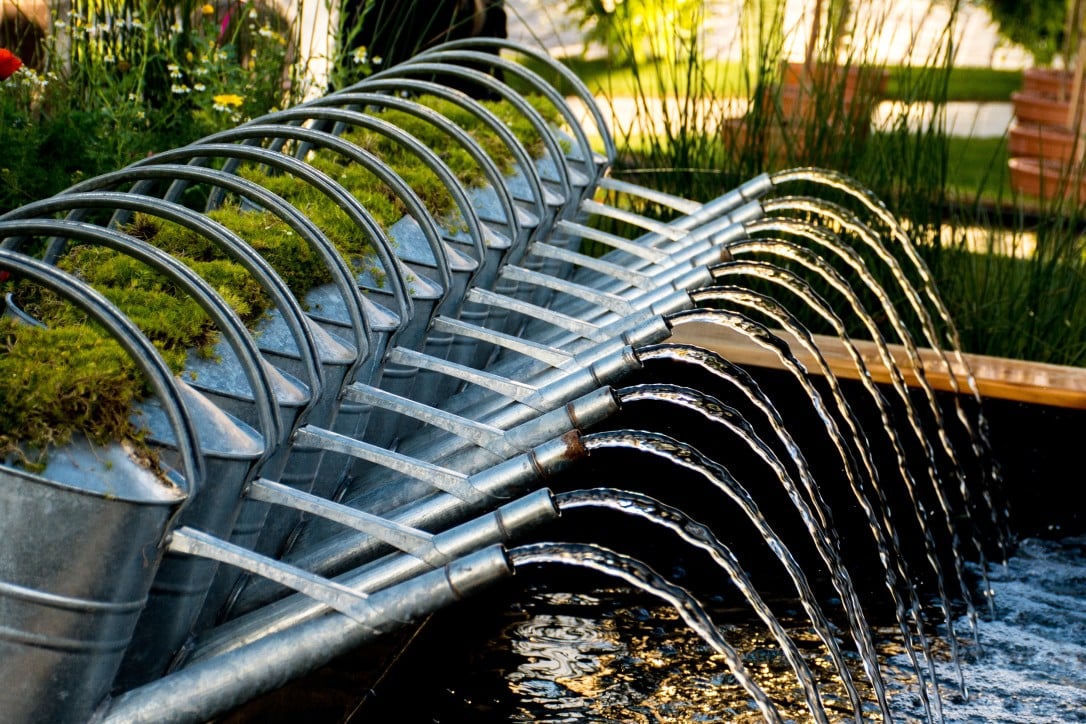
Standing Water
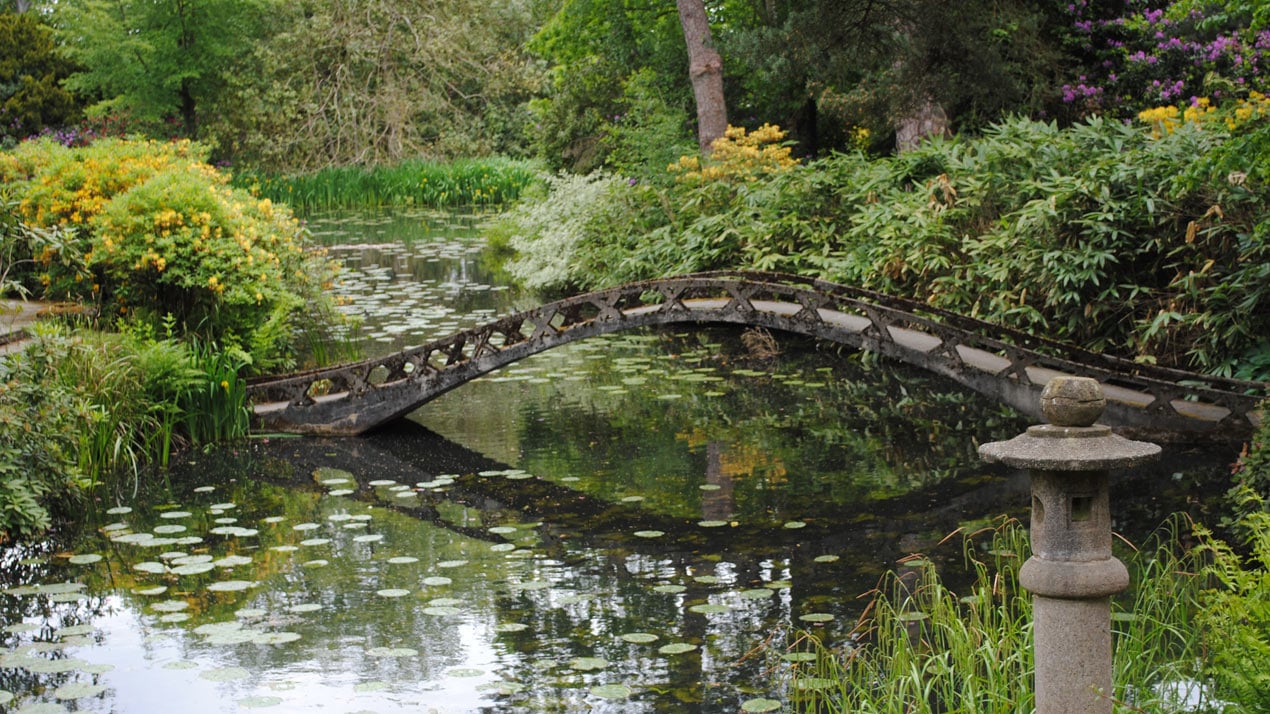
In terms of scale, standing water features have the biggest range in size. They can vary from substantial lakes down to tiny birdbaths. The unifying feature or aesthetic through-line they possess is their stillness, tranquillity and reflectiveness. It is the light and reflections that play on their surface that make standing water features magnificent.
In addition to the beauty they bring to your garden, standing water features also increase biodiversity and give nature a bit more of a helping hand. Lakes, ponds and pools provide habitat and drinking spots to a host of fauna, whilst they can be populated with a decent range of aquatic plants (hydrophytes/macrophytes) that can be planted in or near the water.
Garden ponds
Garden ponds are a more traditional type of water feature that can be customised to complement your outdoor space. You can add mini fountains, a variety of aquatic plants and even introduce fish to your pond. If you put water lilies in your pond, these will open up in summer to add a pop of colour. Ponds are usually excavated, but smaller raised ponds are also common, and provide seating on their edge next to the water.
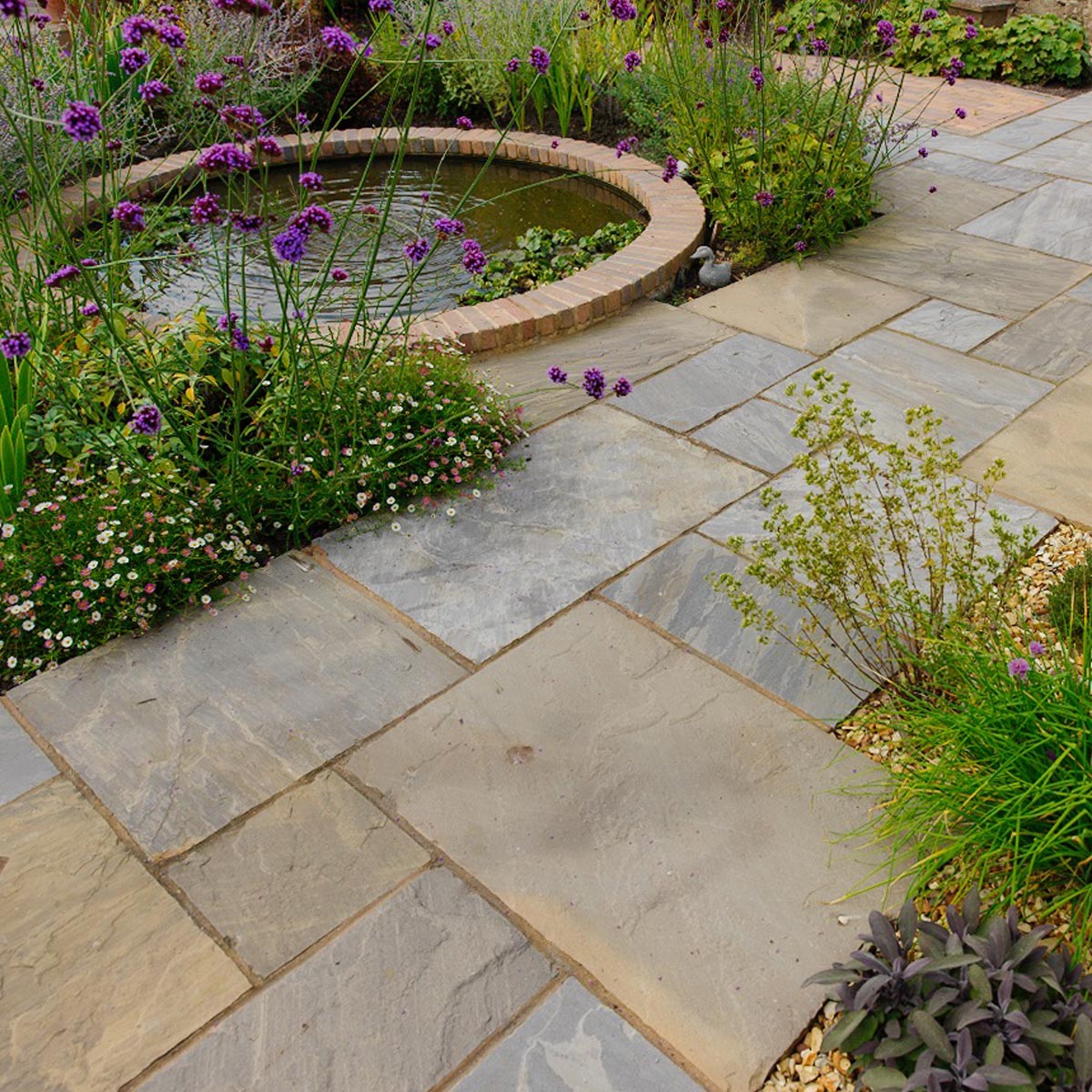
Ornamental ponds
These are more stylised and architectural than ordinary garden ponds, and often will be in closer-proximity to the home and hard-landscaped parts of the garden (patios, dining and seating areas). Ornamental ponds are designed to underscore the architectural aesthetic of the garden. Their function is one of design cohesion, so they should be in-keeping with a wider design vision, and accent design elements found elsewhere in the garden and property.
Ornamental ponds are ideal places to strategically placed submerged and perimeter lighting to provide some wow-factor at night too.
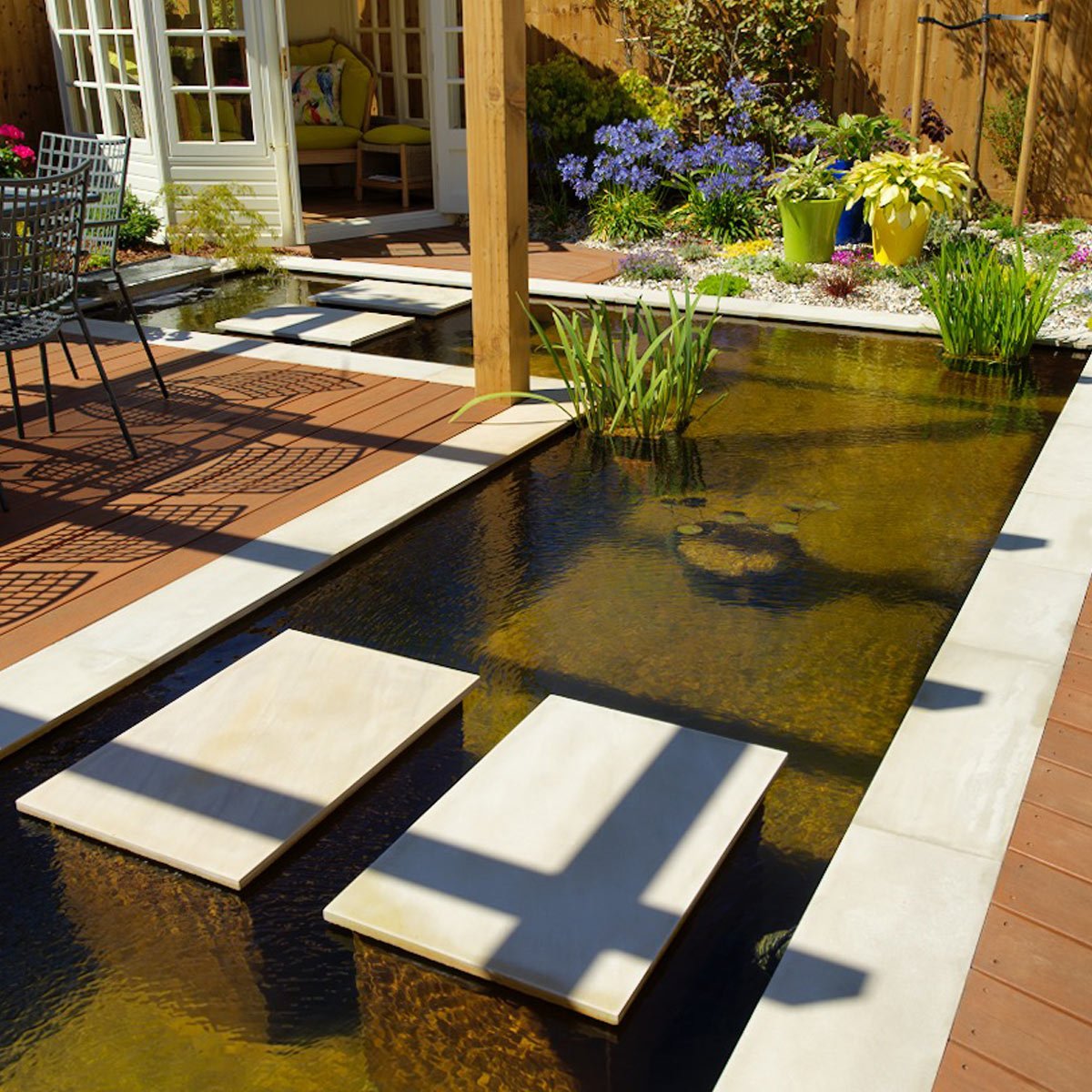
Water bowls & tetsu bachi
A water bowl is a classic and tasteful addition to any garden space. Whether it’s placed on your patio, or integrated into your flower bed, it will attract wildlife and create a calming environment. You could even place multiple bowls in a row to section off your garden. Japanese carved granite tetsu bachi bowls are becoming increasingly popular in the UK, with their simple, elegant lines and subtle aesthetic.
The reflective surface of a water bowl can help to diffuse light around a garden, making it the ideal choice for a shaded corner space.
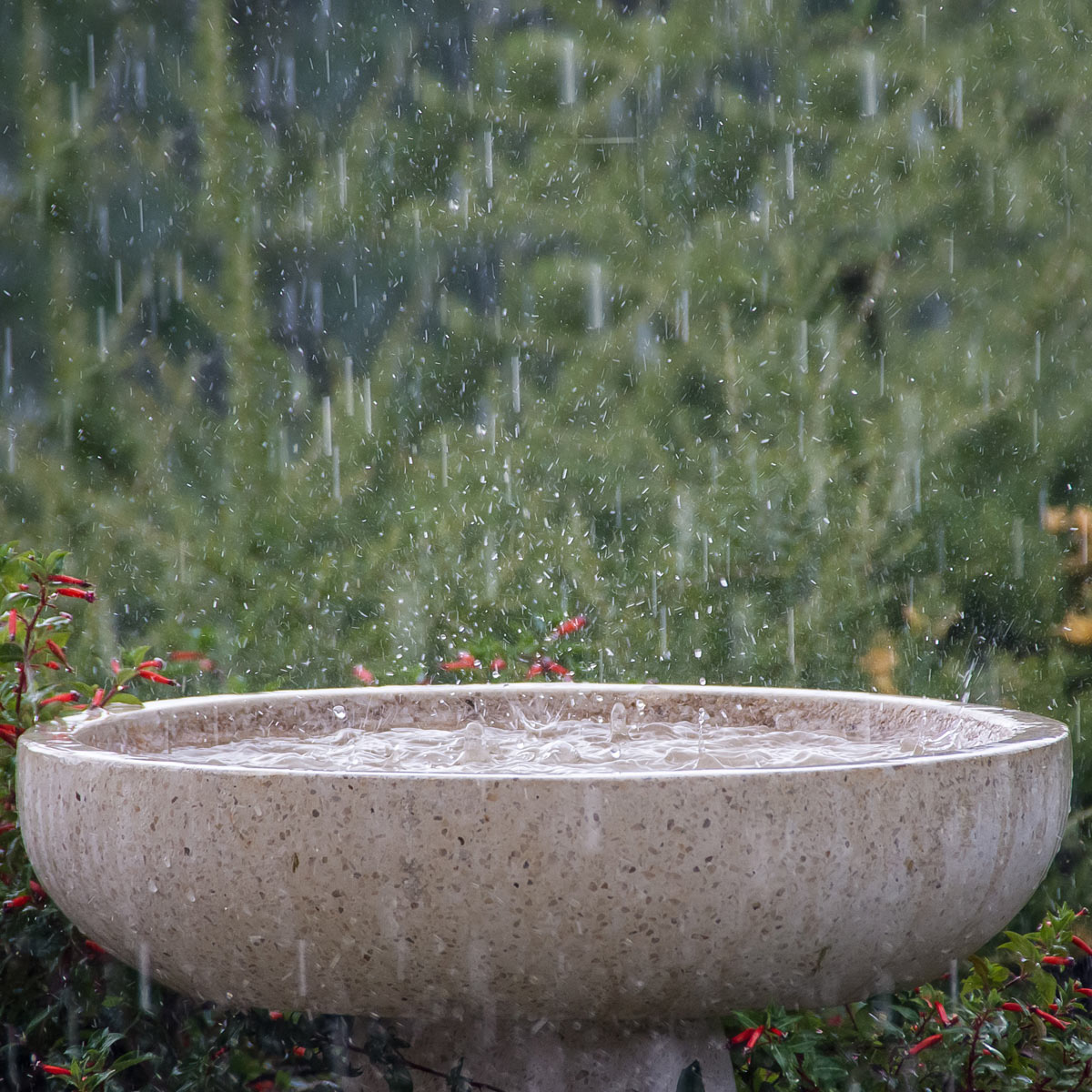
Garden troughs & tanks
Troughs and tanks are great water feature ideas for more bucolic settings, where you need something that looks at home in its rustic surroundings.
Stone, wood and metal are all commonly used for troughs, each bringing their own unique character. Tanks will tend to made of metal, so from a garden design point-of-view, your choice is how to protect the material (galvanised / stainless steel / protective paint) versus the distressed/time-worn appearance one usually wants these agricultural pieces to convey. A rusty tank might look great – but how long will it remain water-tight? There is often a trade-off between form and function.
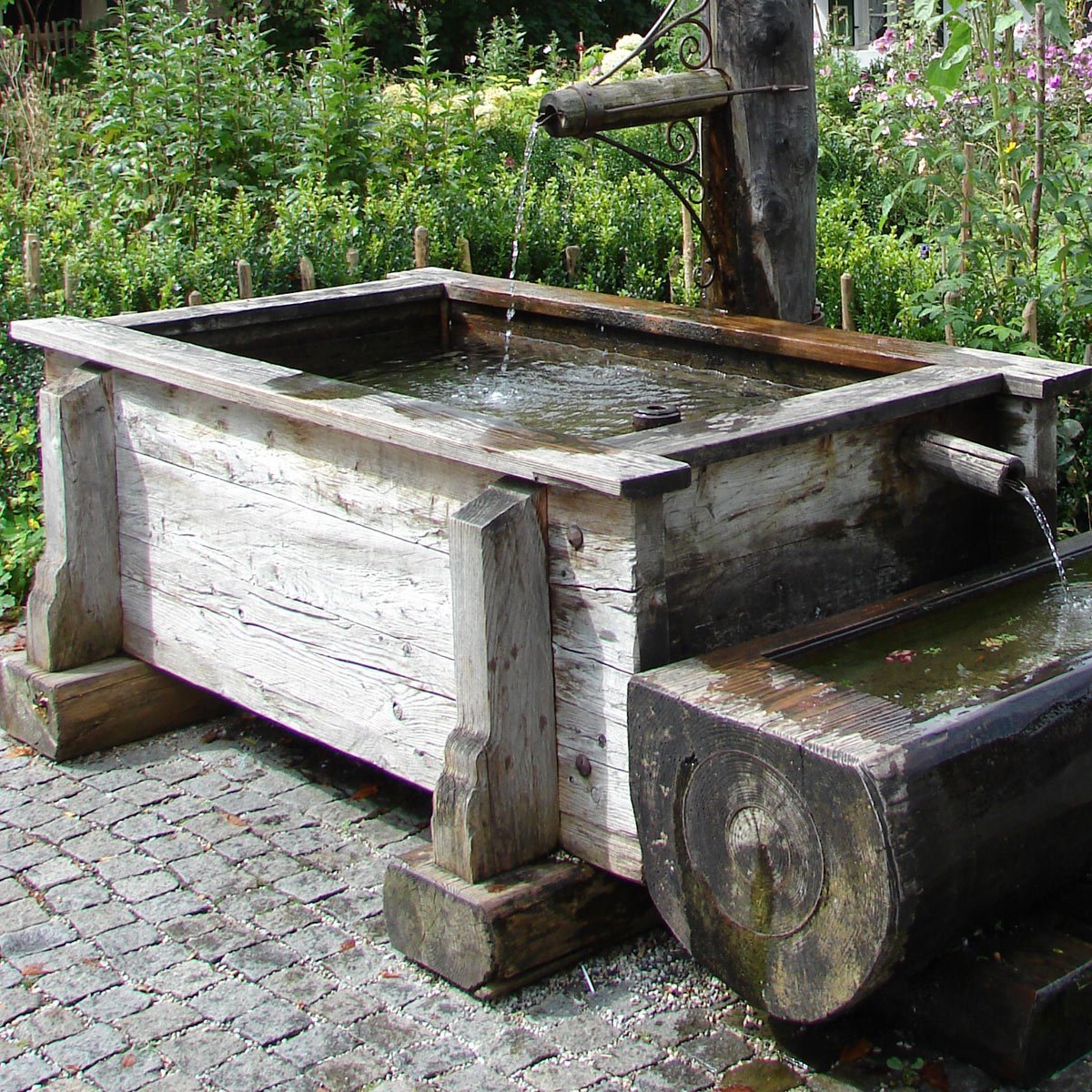
Birdbaths
You don’t have to be a keen twitcher to appreciate a birdbath. Not only will it encourage wildlife in your garden and create an area that attracts birds, but aesthetically you have an opportunity to add something crafted or carved with skill, love and care into your garden.
Whether it be metal, stone or another material, if you choose the birdbath based on its inherent beauty, you’ll have an objet d’art containing a reflective surface upon which light can play, and a rest for birds to come and drink and wash. Win, win!
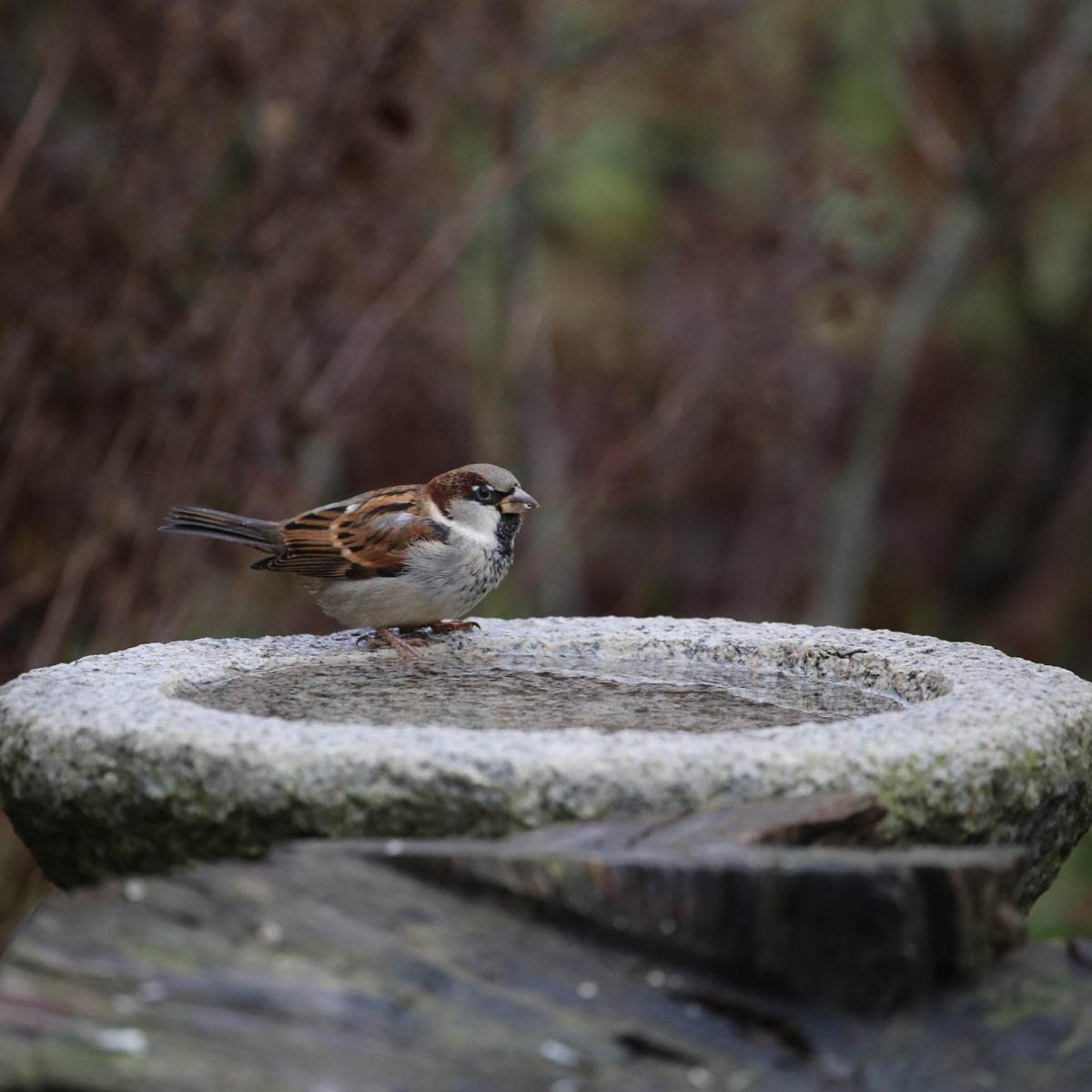
Reflection pools & ponds
Whether you use them to reflect archtectural features when looking towards your property, or the vistas and landscapes when looking out from your property, reflection pools and ponds have high visual appeal and aesthetic impact. They are generally shallow (300mm or less) and located adjacent or near to your property – so you’ll need quite a bit of space to pull this water feature idea off.
The space they need is the downside of reflection pools. Because of the viewing angle from which you’ll generall look at a reflection pool (head height), the image will be subject to foreshortening. Therefore, the reflection pool will have to be quite wide. This is to accommodate enough “canvas” of surface water to capture the foreshortened reflection from its base to the height of property/vista you want to see reflected. That said, they look stunning and have wow-factor on steroids.
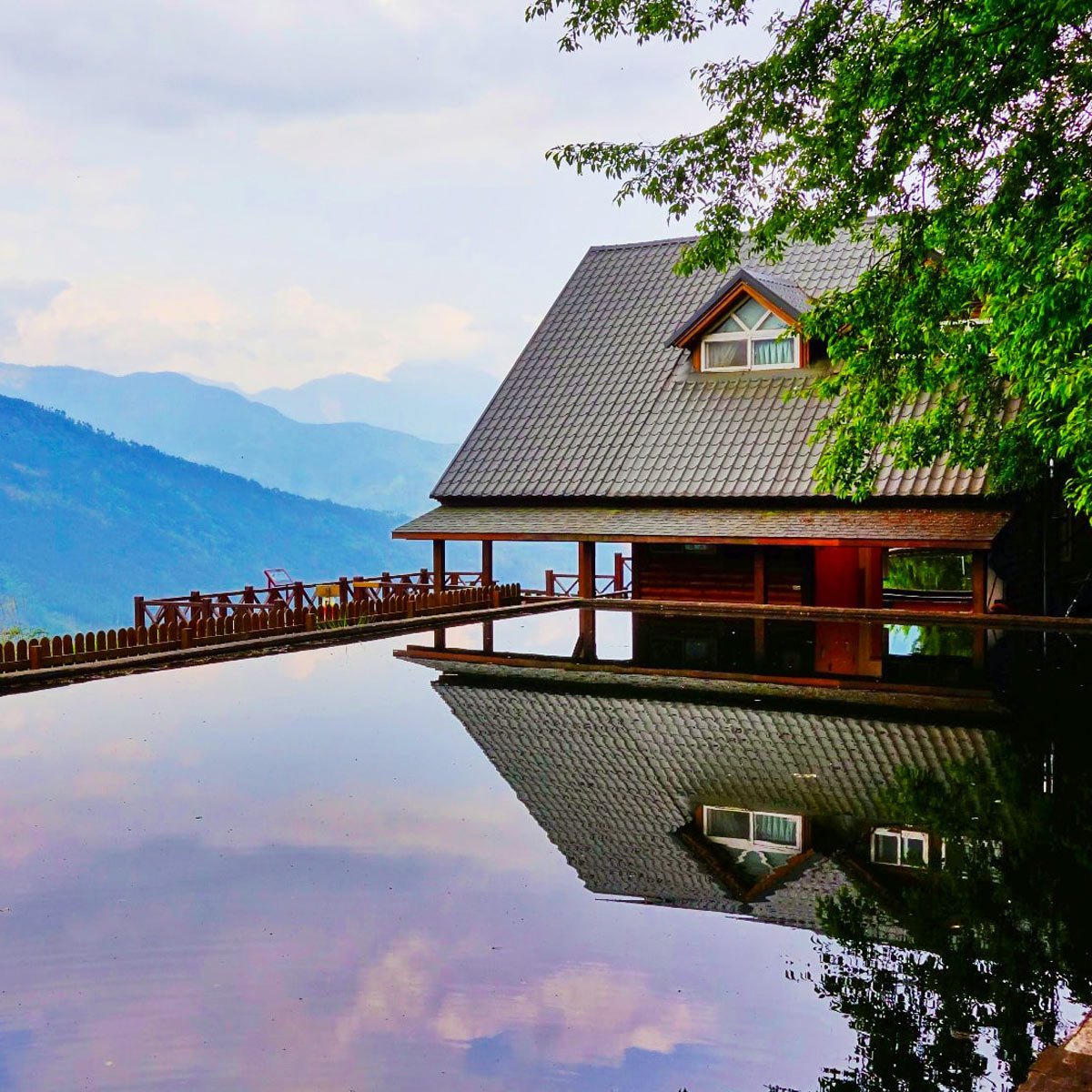
Garden lakes and large ponds
If you have the land and space, a large pond or lake can add significantly to the beauty and aesthetic of your garden landscape. In addition, these bodies of water will significantly improve local biodiversity and improve conditions for all kinds of wildlife and flora.
There are plenty of considerations when designing your lake. Do you want islands, beaches, outcrops, reed-beds, lily beds, jetties or decks, boathouses, summerhouses and so on. As these are fairly mammoth features that require a lot of work and forethought, we definitely recommend some serious planning or even consulting a landscape designer.
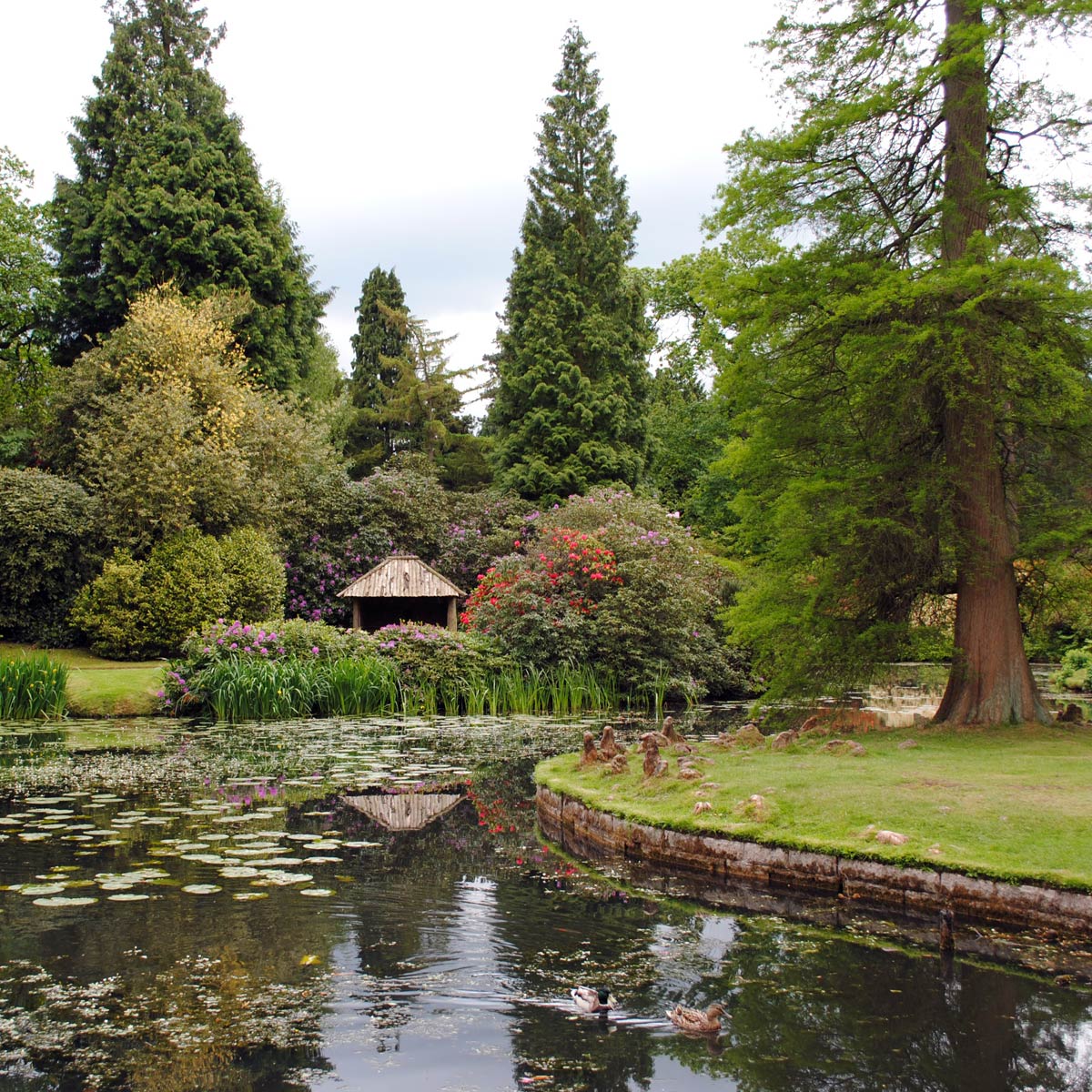
Running Water
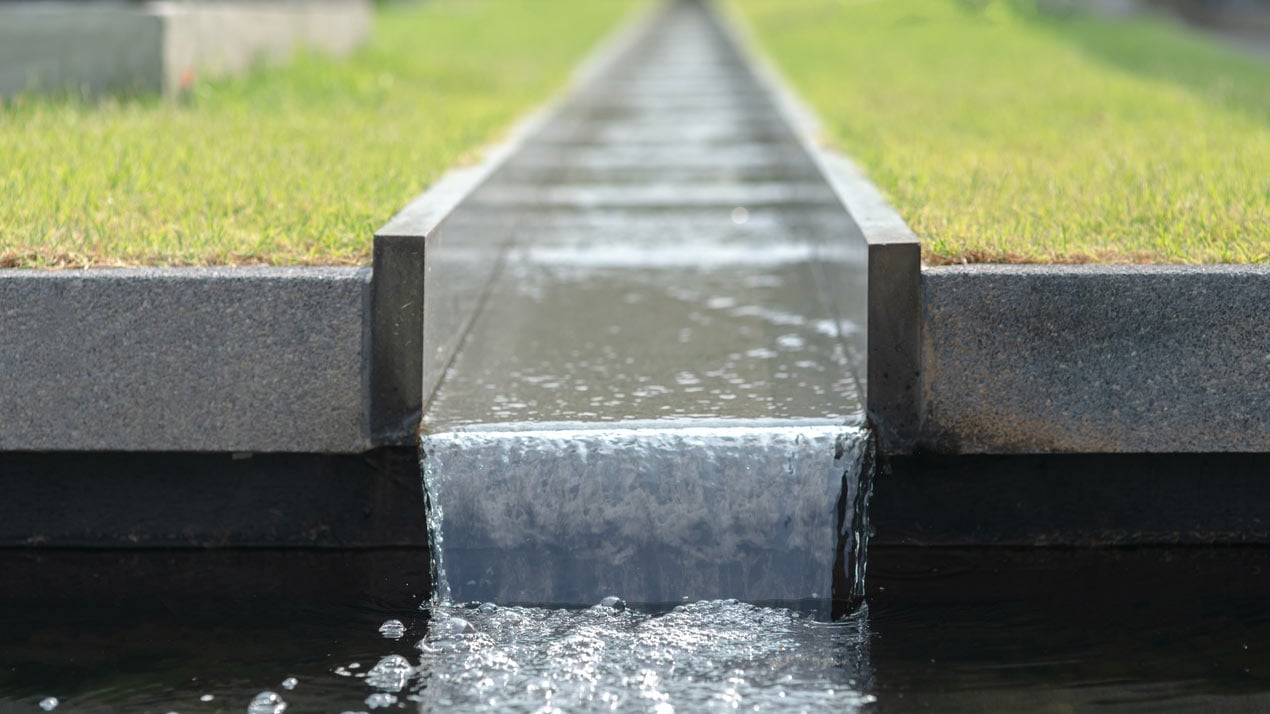
Streams & brooks
You might be very fortunate, and already have a water course on your property. However, if you don’t, that ‘s not to say you cannot! Man-made streams and brooks add so much character and interest to a garden, and can be added to modest-sized gardens with a little imagination and know-how.
Formal designs – you can create quite formal and well-kept brooks, often with shuttered banks, to match wooden foot bridges. This is a look seen often in larger ornamental gardens.
Informal design – If you are after something more wild and bucolic, then stone boulders, cobbles and closely planted shrubs with overhanding foliage will be better suited to form the banks of your brook or stream to give it a natural and rustic appearance.
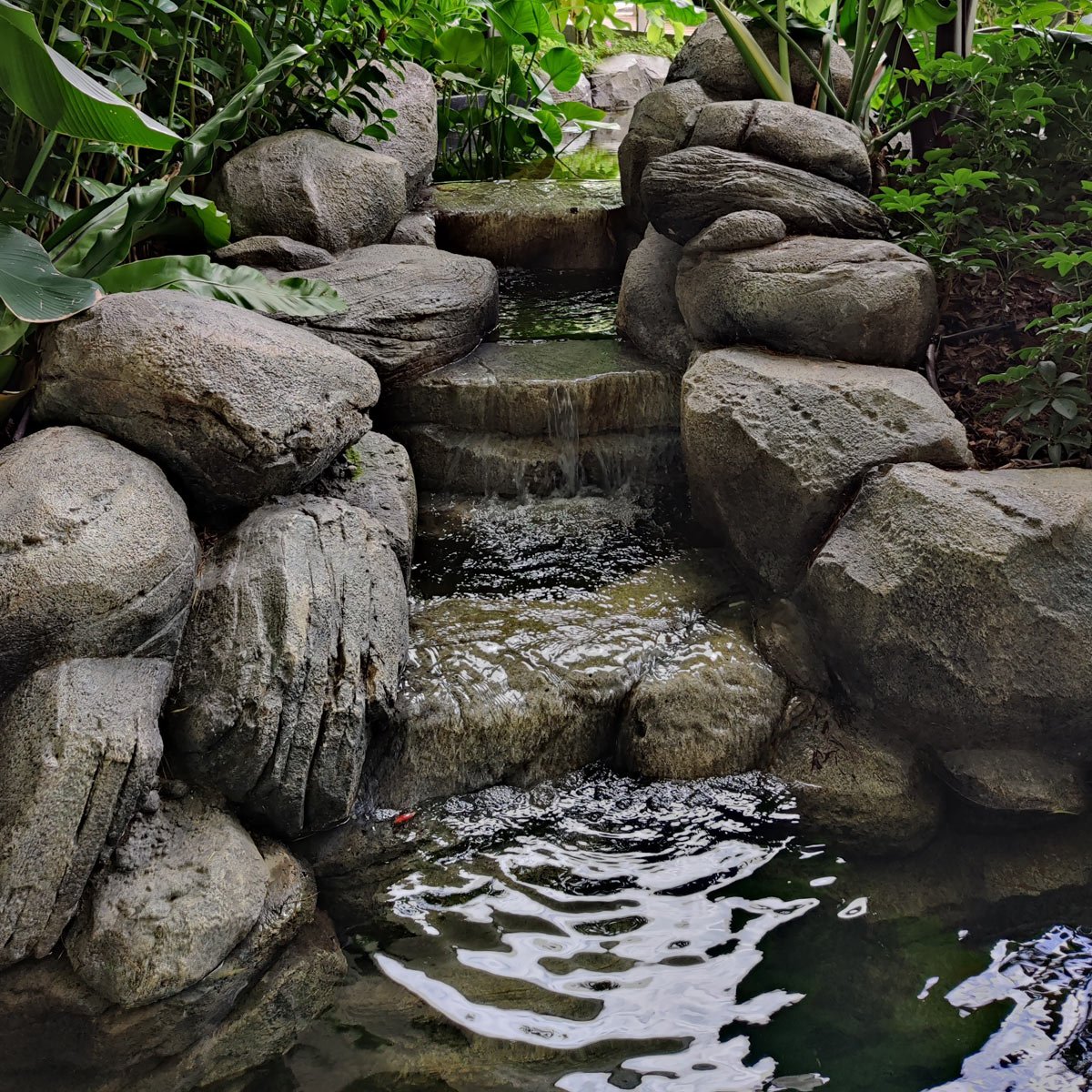
Rills, runlets & rivulets
Rills, runlets and rivulets are ideal water feature ideas for less expansive properties. These are smaller water courses, usually being less than 600 mm wide. Rills will tend to be man-made / formal in appearance, whilst runlets and rivulets are merely synonyms of each other and equate to tiny rivers/stream of any nature.
Rills can be used to great affect in your garden design and are well suited to two key functions: Firstly, they can be used to draw the eye in a linear fashion, pointing towards a garden feature – like a visual arrow “saying look this way”. Secondly, they can be used very effectively to differentiate space and create interesting boundaries between areas. So rather than using an edge course or edging, you install a rill to bisect an area.
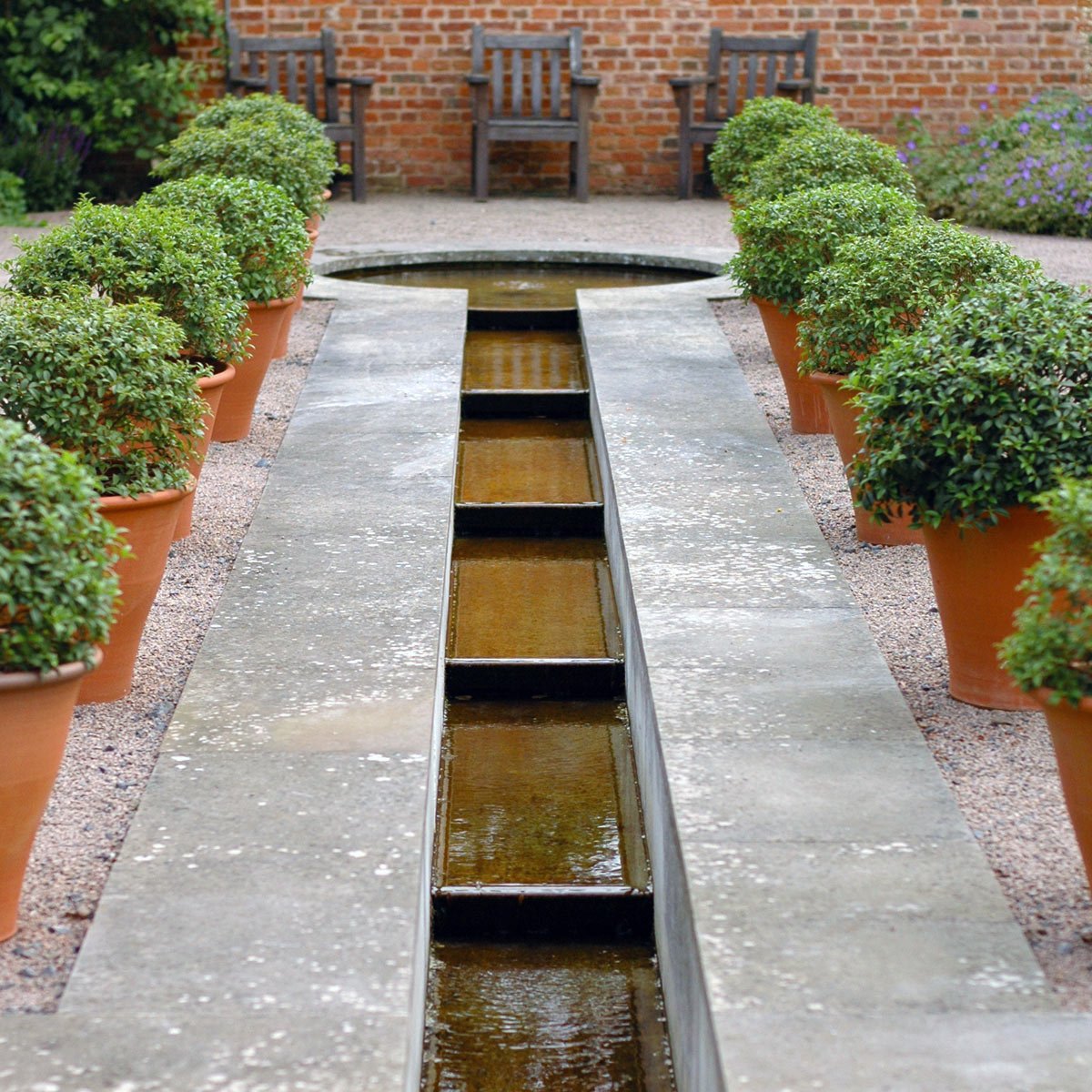
Cascades & Falls
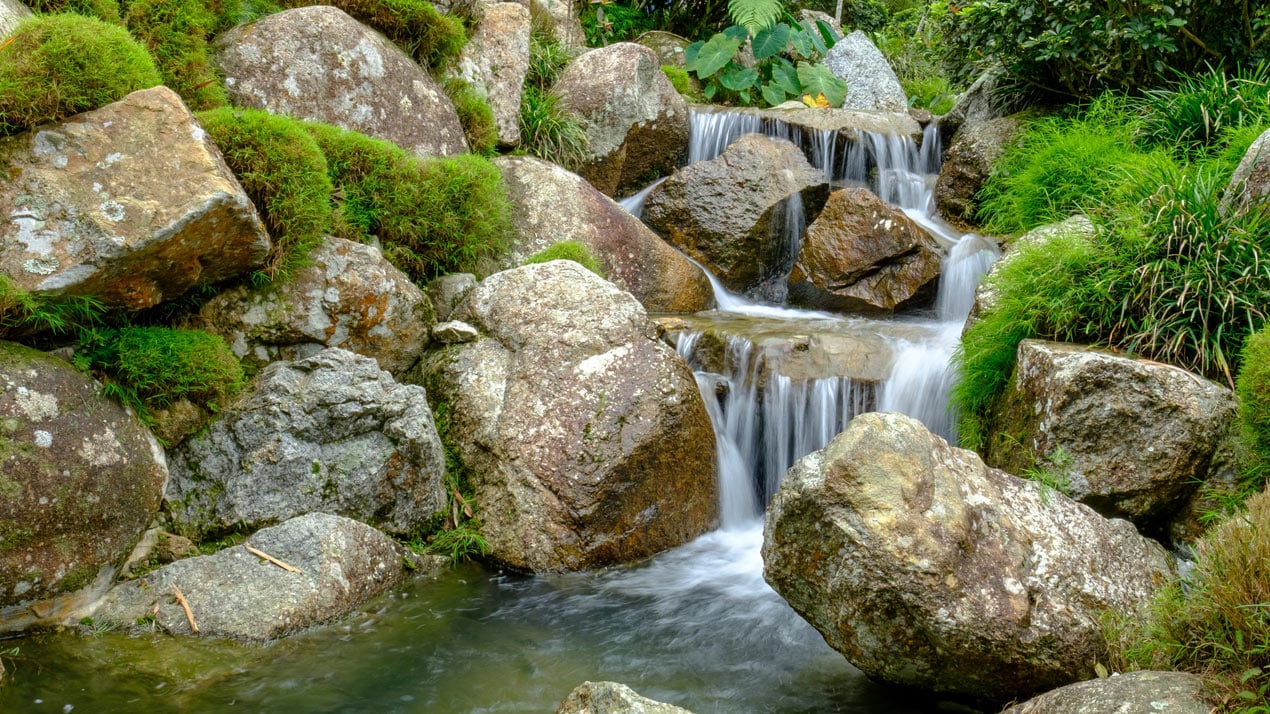
Like an open fire or sunset, humans are naturally drawn and transfixed by the visuals, sound and energy of cascading water. There is something inherent about this attraction, almost as if it is hardwired into our limbic system. Whatever it is driving our love of cascades, if you want a water feature in you garden that gives you serenity and peace, then this might be the one to go for.
As with other water features the size and scale you make a cascade is only limited by the size of your garden and your budget. Cycling and pumping the water from the bottom to the top of your cascade is something you need to consider in terms of budget and energy consumption – and how sustainable you want that to be.
Man-made waterfalls & cascades
Small man-made waterfalls are an impressive water feature idea to consider if you have a tiered garden. Emulating a natural waterfall formation, this feature can offer a sense of tranquillity through the continuous downward flow of water.
You can create a small pond at the bottom, and pump the water back up to the top for a constant flow. Assembling a man-made waterfall in your garden may take some effort, but once installed it will take little maintenance and can continue to bring serenity to your outdoor space for years to come.
The scale of a project like this can vary depending on the space and time you have available. You could opt for a small pond-based waterfall. Alternatively, if you’re looking to create something more spectacular, take a look at these examples of back-garden waterfalls on Pinterest for inspiration.

Garden weirs and small cascades
Lower and smaller than waterfalls, these garden cascades are easier to build and require less energy to run and cycle the water, making them a more sustainable garden water feature idea.
Consider running a brook adjacent to a climbing path, with multiple cascades along the route. As you walk the path the sound of the trickling and splashing water will accompany you along the way.
Create shallow pools and weirs that will allow wildlife to cross, bath and drink at these points.
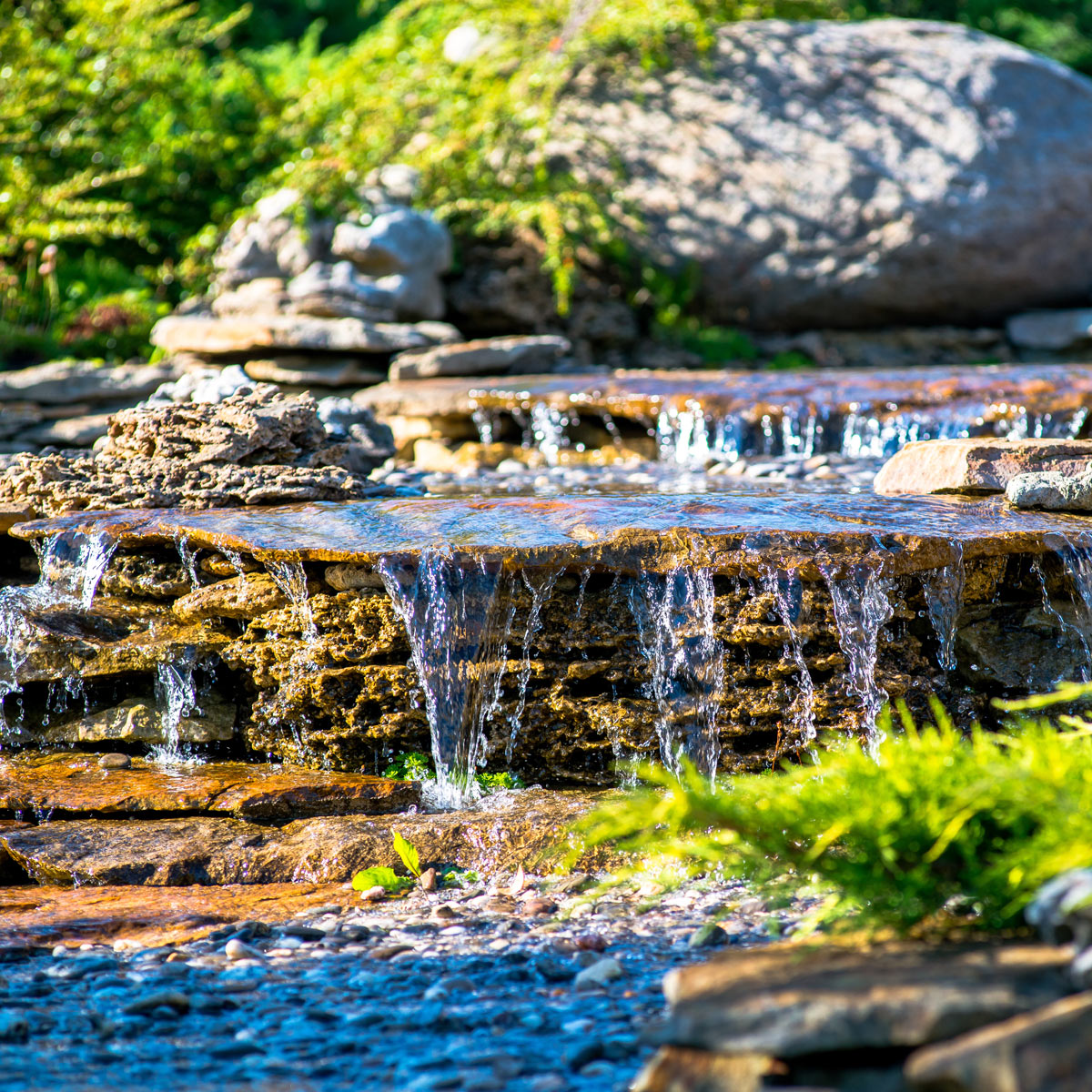
Water blades & scuppers
Scuppers are channels cut in a wall through which water can pass. When a water blade is added to a scupper, they produce a simple and transfixing water feature to a wall. This makes them ideal when used in conjunction with ornamental feature walls.
Usually they will have a pool at the base of the wall from which the water is pumped back up to the blade. Consider added wide coping stones to the pool wall to allow you to sit on its edge and run your hand lazily in the water in the evening sun!
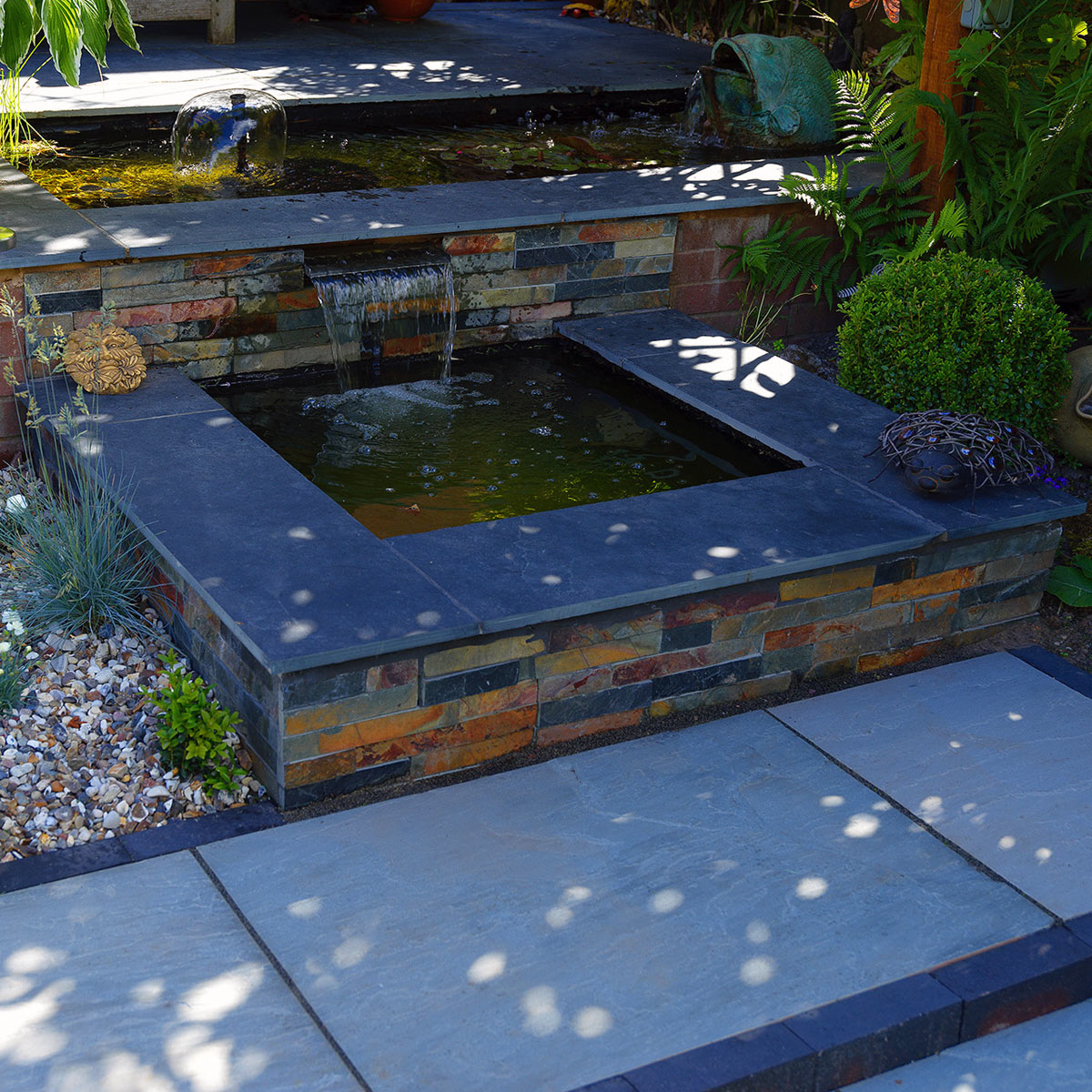
Pondless cascades, scuppers & fountains
Utilising hidden collection pools with permeable materials above such as cobbles and pebbles allows you to present what appears to be a pondless cascade.
As pools and ponds can be a hazard for young children, this allows you to create a more child-friendly water feature with plenty of visual and sensory impact, and some added peace-of-mind.
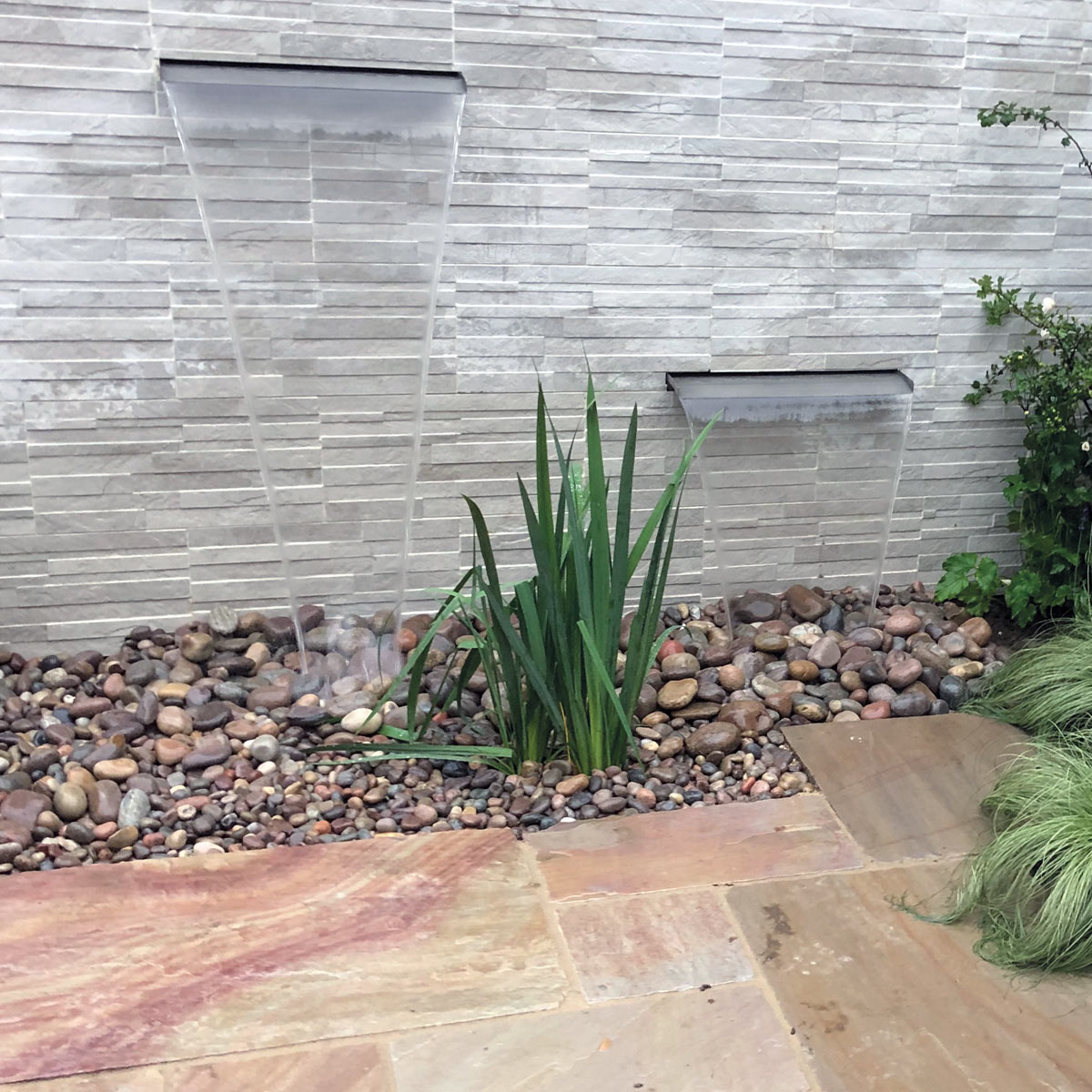
Stepped cascades
Having terraced or stepped cascades looks great and can also offer an area to play and relax in hot weather too. By making the tiers from steps, you are inviting people to walk and play in the cascade. Remember, design is about signalling the function as well as considering the form, so the wider and easier to navigate the steps are, the more you will signal that you are invitating people to play.
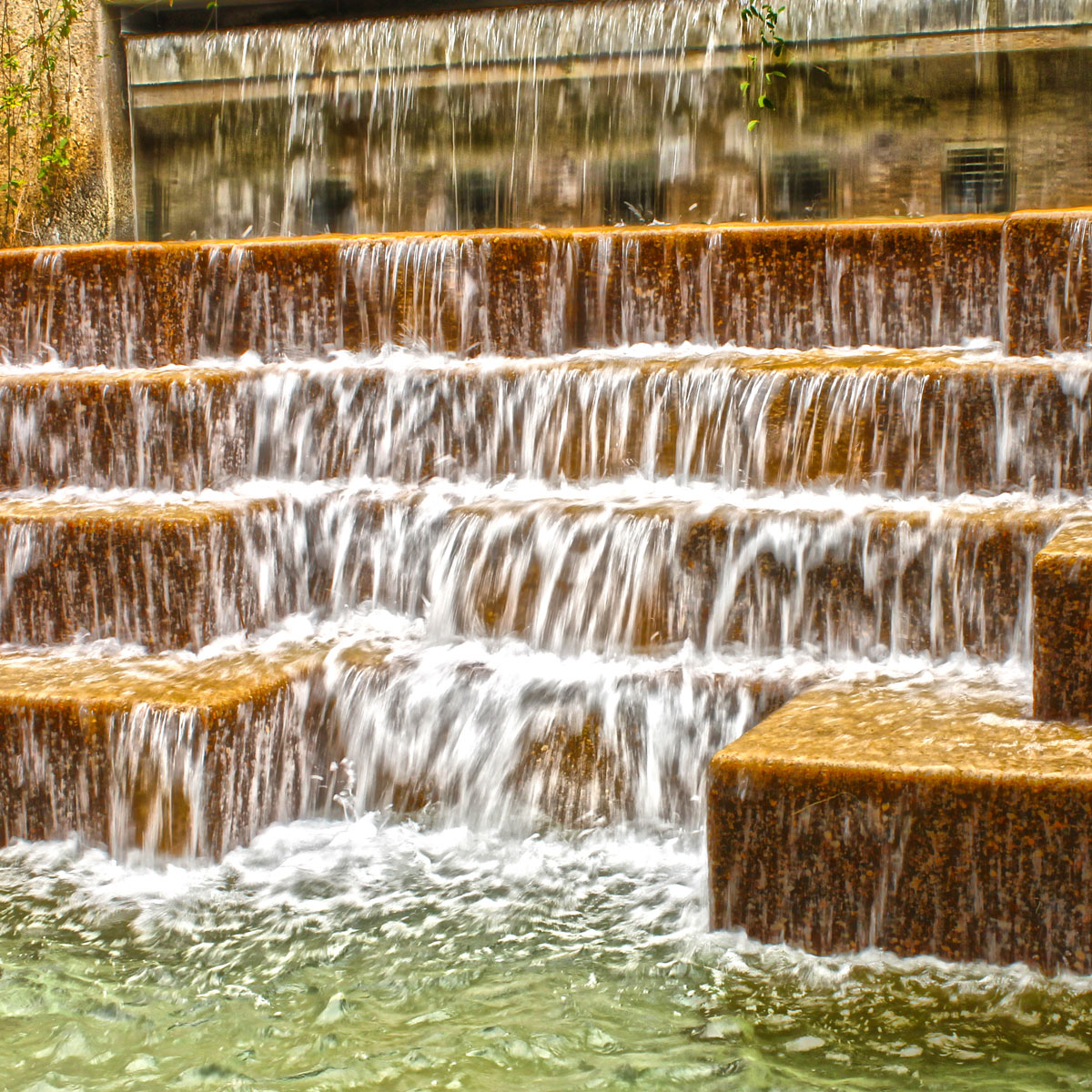
Chadar (textured water chutes)
A visually interesting style of cascade orgininating in India, a chadar (water chute) is an angled face of approximately 25-60 degrees that uses textured masonry to create a series of small tubulent cascades as the water passes down the chute.
The chadar’s strengths lie in the visual appeal of the pattern of whatever texture masony you use, and the excited nature of the descending water, creating white water that catches the light. The texture masonry design is only limited by your imagination, and common patterns seen incorporate chevrons, half moons, shells, leaves, diamonds and stars.
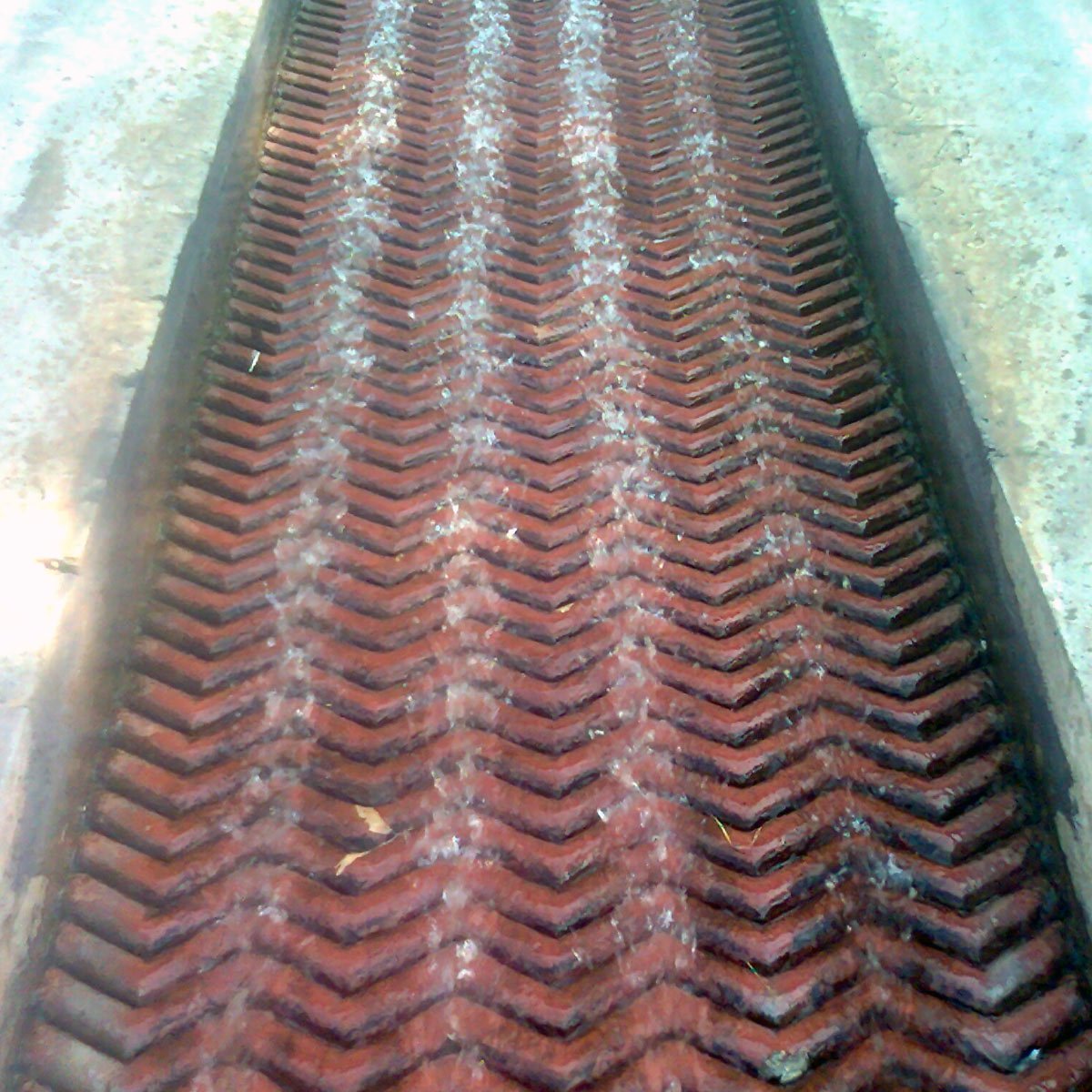
Rain curtains
A very simply but dramatic design device that allows you to channel people in the garden. These are ideal adjacent to walkways to add dramatic flair. They can also be used to create visual screening between areas of the garden or obscure a view that cannot be blocked in more conventional ways!
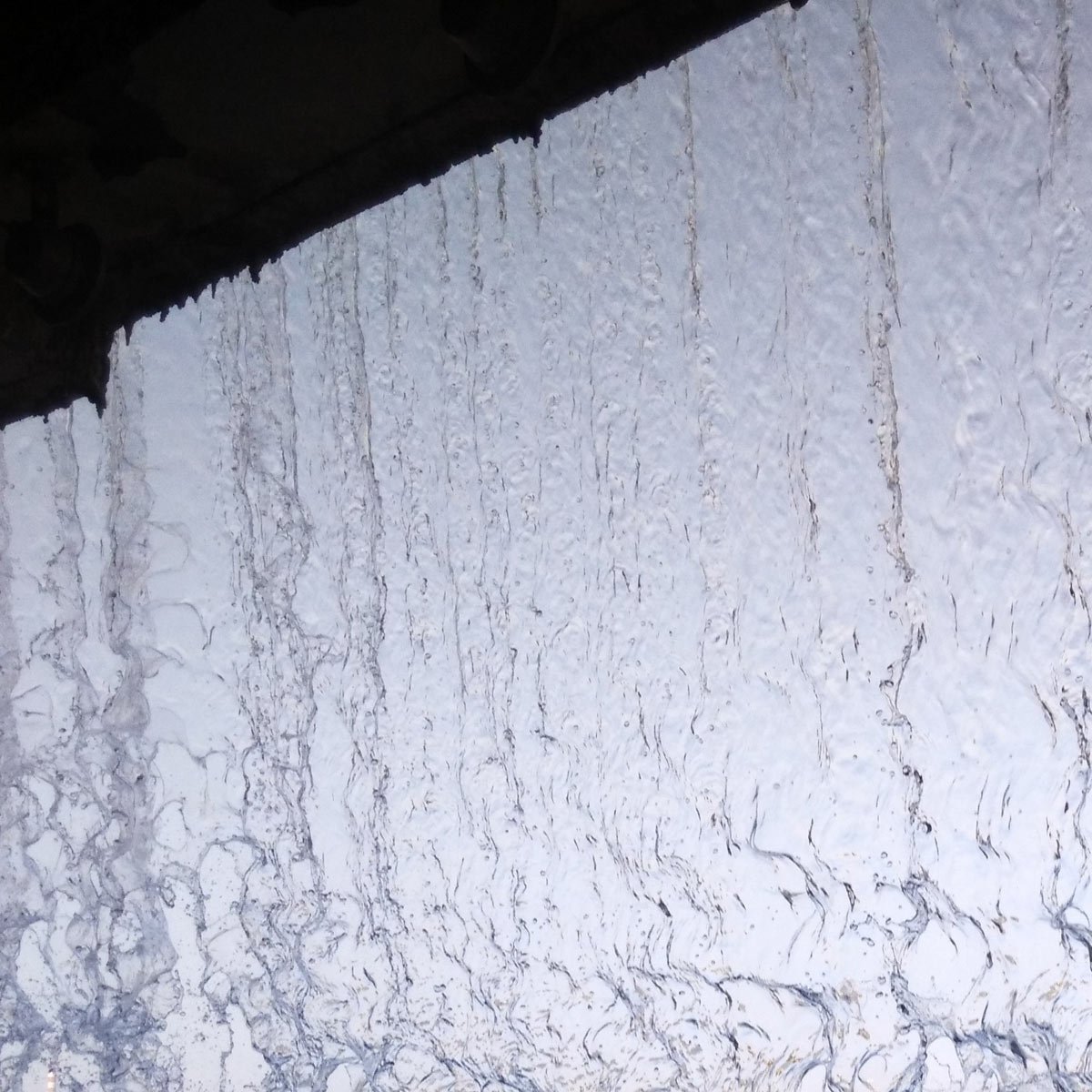
Design elements
If you are thinking about introducing a water feature into your garden, then there are quite a few design considerations to weigh up and contemplate.
Below, we summarise some of these considerations and show you some examples of options you can review.
Smaller scale & compact water features
You might have a small garden or space within your garden in which you want to put a water feature, but it cannot take up too much room. So you’ll find compact and self-contain water features ideal in these situations:
- Standalone vertical plinth fountain – the nozzle is in the pool and this offers a nice self-contained and compact water feature option that can be used as a centrepiece.
- Iwa Bachi, Natsume Bachi & Tetsu Bachi – these Japanese water features combine a bamboo water pipe with a bowl/basin and offer a compact water feature option.
- Small ornamental ponds – these can be as small as one metre wide, but provide the visual impact in a confined space you require.
- Standalone wall mounted sconce fountains – these are designed to be installed against an existing wall, often in a nook or alcove.
- Flowing jugs/urns – there are standalone flowing jug and urn water features that can be used similarly to plinth fountains (although not all utilise a plinth in their structure).
- Feature wall water blade scuppers – scuppers/water blades can be really quite small (a few centimetres wide) if required, so even with very limited wall space, you can introduce a water feature.
Views / vistas
The size of your garden and budget will be key considerations when planning your water feature project. Remember that bigger projects can be done in phases, and that as long as you have a plan, you can make the chunks of work manageable.
When it comes to the vista/view you are looking to create, consider the background, scale and depth of the area you are working in. For example, using height changes and terracing, can make a smaller garden space appear bigger, with more depth.
What does the background view of your water feature look like (both looking at the property and outward to the surrounding landscape)? Will the water feature need a backdrop or screening to make it look right?
When weighing up different water feature ideas to enhance the surrounding area in your garden, you might want to consider:
- Using a water feature to add visual interest in large open spaces
- Using a water feature to direct or draw the eye to specific views or features
- Using differing heights to create a greater sense of depth to your garden
- Using water features to add interest to plain facades and walls
- Using screening and planting to accentuate the water feature.
What’s going in your pond or lake?
Part of the fun of creating a new pond or lake is deciding what you are going to do, not just with the perimeter and surrounding space, but what you might also put in the water itself!
- Planting – what aquatic plants will you use. Which ones will you use to oxygenate the water?
- Are you stocking the lake or pond with any fish?
- Do you need any stepping stones, walkways or bridges?
Sculptures & objet d’art styles
With many types of water feature, one can incorporate sculptures and objet d’art to provide an aesthetic style. So consider what style and type of art you want to incorporate, and whether that is representational or abstract, in man-made or natural materials, contemporary or traditional? Also consider, do you want the art as a centrepiece or adjacent in a supporting role?
Fountain nozzle type
If you plan on installing a fountain, then you’ll need to choose what style fountainhead / nozzle you want.
- Standard nozzle – this is a turbulent jet flow that can be used vertically or horizontally and the size of the jet adjusted by water pressure.
- Fan nozzle – this fountainhead splits the flow into multiple jets to create a delta-fan shape. These are usually vertical installations.
- White-water foam nozzle – this fountainhead creates a frothy white-water foam jet that offers lots of visual volume via the foam-effect.
- Laminar flow nozzle – these create flows of fluid particles following smooth paths in layers. These appear smooth and solid, like perfectly cylindrical beams of water.
Custom design & builds
If you’re looking for something truly original and unique, and you want to really blow people away with your water feature, then you might need to get something built bespoke.
If this is a route you want to go down, then planning, sketching/visualising and attention to detail in conversations with your artisan fabricator or craftsperson is critical. If you can, get an agreed fixed-cost price before any building or fabrication occurs. Get scaled drawings if possible too, and before accepting delivery ensure all dimensions and materials are as specified on the signed-off drawings.
Choice of materials
As with all landscaping and building projects, your choice of materials will impact the aesthetics.
With water features, you will usually need to choose materials that will not erode (well, at least not immediately) in contact with still and/or moving water.
As well as the materials’ durability with water, consider both how it looks and sounds too:
- Stainless Steel – great when using its reflective surface with moving water.
- Bronze – deep rich colours and contrast of burnished and unworn areas
- Stone – weathered and older looking natural stone can add a real rustic appeal.
- Concrete – can be cast into interesting shapes and be engineered to do things that would be more difficult or expensive when done in stone.
- Porcelain – as porcelain (and slate and granite to a degree) are waterproof, this makes it a great material when you need to protect an area and prevent water permeating (for example cladding a wall for improved weatherproofing against spray/splashed)
- Wood – You can let this gracefully decay or treat it (tung or linseed oil) to help preserve it when used in your water feature.
- Bamboo – has better durability than wood in and around water, so offers an organic aesthetic that will last longer.
Conclusion
Start designing your new water feature today
This post has explored some potential garden water feature ideas for you to consider, from small gentle and relaxing water fountains to large striking man-made waterfalls.
We offer a range of products that can enhance the setting of your new garden water feature, including circular paving and garden edging for features and centrepieces, through to split-face cladding and garden walling for constructing your project. For more information or advice on your next garden project, get in touch with our expert team today.
Found this useful? You may also enjoy reading some of our other garden inspiration blogs:

